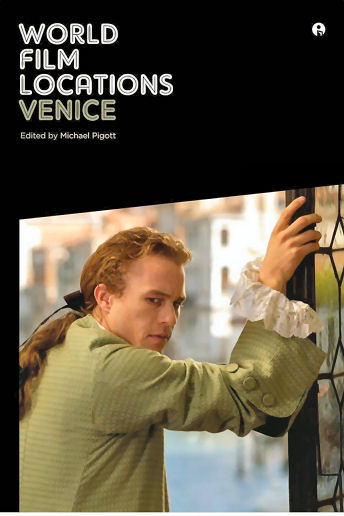Agostino 1962
Directed by Mauro Bolognini, who more than 20 years
later would direct La Venexiana, this film is based
on an Alberto Moravia story. It concerns a head-turning woman -
played by Ingrid Thulin with one of those flicky-uppy Mad Men hair
styles - on holiday in Venice with her clingy son. She takes up with a charming Italian, played by John Saxon, thereby
leaving her son to the attentions of a trunks-clad beach gang of boys led by
an older man, with all the creepy scenarios thereby suggested not
exactly played down. I have a shaky and
cropped-looking file of this, with subtitles that are both bad and florid
('How grim a chat'). So I am not exactly keen to watch it, given
that it also looks to be mostly set on the Lido, and child-sexualising and dubious
to boot.
Ancora una volta... a Venezia
1976
Only ever released in Italy, online plot-summaries in
Italian suggest a romance, with a reunion in Venice later brought about by
events that include a kidnapping that goes wrong and a subsequent suicide.
Anima persa 1977
A horror film featuring Catherine Deneuve, given the
somewhat plot-spoiling title
The Forbidden Room in English but seemingly never released in any English-speaking
country. It's about a young man coming to Venice to study art, staying in a
creepy palazzo with his aunt and uncle, and coming to wonder who might be locked
in the attic. It's said to be atmospheric and to give good Venice.
The Anonymous Venetian
Anonimo Veneziano 1970
A man meets his estranged wife at Santa Lucia station,
off a train from Ferrara where she's been living for years with a wealthier
man and their children. Why is she back there, she wonders - is he finally
going to give her a divorce? They walk around Venice, with no consideration
for geographical reality, remembering good times and raking over old wounds.
It's a wet and wintry Venice and it looks as dirty and crumbling as 1960s
Venice tends to. As their emotional roller-coaster progresses around many
wet campi you brace yourself fatalistically for the predictable 'shock'
revelation/explanation that he's called her there because he's dying. It's
that kind of a film, the kind that makes you appreciate how well made and
creative and imaginative other films are. The subtitles are not the best
either - prone to grammar slip-ups and mistakes like Piazza San Marco being
translated as Plaza San Marco, and Giudecca becoming 'the Jewish quarter'.
San Vidal is correctly translated as San Vitale, though, as the church where
the man is going in the evening to rehearse an oboe concerto by an Anonymous
Venetian composer, and the final scene is actually filmed there.
A feast for location spotters, but not very filling if you're craving
more substance. You can get a DVD of this from
moviedetective.net.
The Aspern Papers 2018
The pre-viewing fascination with this
film is that it stars Vanessa Redgrave and Joely Richardson, along with Jonathan
Rhys Meyers. VR is JR's mum in real life, of course, and here VR plays JR's aunt. Also
JRM was married to JR, when he was Henry VIII and she was Catherine Parr, in
TV's The Tudors. Michael Redgrave, Vanessa's father, adapted The
Aspern Papers for the stage in 1959, and in 1984 the play was revived
with Vanessa Redgrave playing Miss Tina, the part played by Joely Richardson
here. Cara Delevingne's big sister and Roman Polanski's daughter are in it
too - a large proportion of the actors here seem to be ex-models. Anyway, the film itself is a handsome production,
using four Venetian palazzi - the Soranzo Cappello (for its garden), the Donà dalle
Rose (views across to San Michele), Gradenigo (arched canal-side entrance), and
the Widmann (interiors and arched canal-side loggias) - with more location filming from distances and
at angles that exclude crowds. The acting is a bit stilted at first,
especially between Richardson and Meyers - the central relationship - but as
they are meant to be fencing at first, this is forgivable. Richardson's
growing confidence matches pace with Meyers' increasing desperation, but Vanessa Redgrave
dominates effortlessly. With the concentration on the strength of the
female, and the more than strong suggestion that the secrets in the
letters concern Aspern's sweaty bisexuality, a more contemporary feel is achieved. Also
there's the
flashbacks, enabling some sensuality, thumb sucking and firm young flesh, and the dream
sequences, with their blood and violence. But the name of James Ivory
amongst the producers is more indicative of the respectful tone here. A watchable,
capable and handsome piece of work, but it will win no awards.
Avenger of Venice Il ponte
dei sospiri 1964
This was made in the 60s and is in colour, but in
style it's like an old Hollywood swashbuckler of the 40s - all spectacle and
pomp and broad gestures. Our master swordfighter hero even laughs like Burt
Lancaster as he disarms an opponent and tips him into a canal. The part is
played by Brett Halsey, who went on to appear in everything from The
Dukes of Hazzard to Godfather III, but here he is the
plotted-against Doge's son framed and arrested for a murder, who escapes by
tunnelling out of prison - tunnelling underground always being an
interesting activity in Venice, there being no ground to tunnel through.
There are a few good outdoor location sequences, mostly around the Doge's
Palace and it's courtyard, but also on Torcello and the lagoon.
Most of the action, and lots of lengthy
exposition and tedious fiendish plotting, takes place in semi-convincing
sets, though, which, like most of this film, has an air of authenticity but
doesn't really stand up. This is actually a remake of a film made in 1940
(based on a novel called Le pont des soupirs by Michele Zevaco) also
in Italian, which may explain its old-fashionedness. Maybe if they'd spent
some of the piles of ducats obviously invested in the plush costumes on a
better script this might have been a bit less creaky. One to enjoy on a rainy Sunday
afternoon I think.
Blame it on the bellboy
1991
The plot for this one revolves around some three-way
mistaken identity involving a hit man out to murder a Mafia don, a lowly
worm sent to buy a villa for his abusive boss, and a Lord Mayor out for some
extra-marital hanky panky. Their names are confused by an h-dropping
bellboy and much 'hilarity' ensues, like birds getting accidentally shot
when the hit man is distracted and a fat man wanting to have sex with a
skinny woman and getting stuck in revolving doors. Then later on some
briefcases get mixed up. Sigh! The actors aren't bad: Penelope Wilton, Bryan
Brown, Richard Griffiths (Harry Potter's step-father) and Alison Steadman
all do their best, and Dudley Moore does very little, in what was to be his
last big-screen appearance. From the credit sequence this starts out looking
like a slick travelogue, and sounding like a cheesy one - so that every time
Patsy Kensit appears the music lapses into that sleazy sax playing that
always used to signal 'sexy babe on screen', in case you wouldn't have
noticed otherwise. But like a travel video it gives good Venice, and
features one of my favourite Grand Canal-side palazzos in the plot (the Palazzetto Stern,
pictured right). But apart from that it's really one
of the worst most bone-headed comedy films you're ever likely to suffer.
Blume in Love
1973 Paul Mazursky
George Segal plays a lawyer looking back on his failed
marriage as he wanders around Piazza San Marco wearing a bad beard. This was
reported to give good Venice and to be a quirky gem, but these reports lied.
There's little Venice beyond the Piazza, and the film is pretty much your
standard 70s sub-Woody Allen relationship movie. Promiscuity, talking
mystical tosh, doing meditation, strumming folky music, visiting shrinks,
eating humourous vegetarian food, spouting right-on politics...it ticks all
the boxes, but it just ain't sharp or funny. Marsha Mason is the only person
you don't want to slap, and then there's the ending!
Spoiler warning - Segal wins his wife back from Kris Kristofferson by
raping her, so that she gets pregnant and they have a romantic reunion, in
Venice! A sick-making Hollywood ending, and a deeply dubious message.
Book Club: The Next Chapter
2023
In which four famous actresses of a certain age go on a soft-focus trip
around Italy. I sampled this to see if it was as bad as the reviews made
out, and my first sampling was a 'joke' where one of the women puts her
friend on speakerphone whilst in a church just as she says 'Holy Fucking
Shit!' The party's first water-taxi upon arriving in Venice takes them
on a geographically impossible tour of the usual sights. Everything is lit
low and glowing, all the men they befriend on their first day have accents,
and then they're off in a little red car to San Gim and Florence with much
spectacular landscape photography. But Florence only features as somewhere
they fly over in a helicopter to dump a husband's ashes in the Arno. In the
end tedious family values are reinforced it seems. Oh well.
Bread and tulips
Well here's something you don't see everyday - an Italian film
set in Venice. It's about a housewife on holiday who gets left behind
when the coach carrying her family leaves without her. She decides to return
home under her own steam, then she decides on a detour to Venice, then she
decides to stay. She meets a waiter who speaks like a book and offers her a
room in his flat. She gets a job with an anarchist florist, befriends a
masseuse, and rediscovers the sensuality of the accordion. This is an odd
film, with an Anne Tyler-type plot, low-key humour, and some dream sequences
with more than a tinge of David Lynch about them. But it works, hangs
together, involves you, and leaves you smiling; but not feeling manipulated.
Venice is a lovely backdrop, without the kind of lingering and worshipful
camerawork a non-Italian would indulge in. A rom-com maybe, but with reality
and bite - I liked it a lot.
Brideshead Revisited 1981
When Charles and Sebastian visit Venice their
gondolas arrive at the Palazzo Contarini-Polignac, but once inside they are
miraculously transported to the Palazzo Barbaro (before its recent clean)
(see photo above right) and here they stay as guests of Sebastian's father,
the interiors being filmed here,
including the courtyard where they all have breakfast. There's a pre-cleaned
grimy patina about most of the places they visit, in fact, in this
lovingly-written and filmed episode. The book and the series contributed
more than a little to my mental Venice before I got to see the real thing.
The 2005 UK DVD reissue (with commentaries and a documentary) is said to
have better picture quality than the set from a few years before which I
bought, but is still not what you'd call good.
Similarly the recent (2012) Anniversary Edition Blu-ray was reported to have better picture
quality, but to suffer from seriously washed out colours. Maybe one day a
respectable restored edition will appear, as of November 2025 there's just a
Spanish Blu-ray, which will set you back £84 on Amazon.
Brideshead Revisited
2008
By the time I got to see this on DVD my
expectations had been made lower than low by the reviews and reports, and so
I had little room for disappointment. It's like one of those cut-down
versions of famous films done in five minutes with Lego or sock puppets. You
wait for famous bits to happen and they all whizz past in imitation of the
TV series. The only sustained pleasure and surprise comes courtesy of Emma
Thompson who makes Lady Marchmain much nastier here, and her confrontations
with Charles fairly fizz with animosity rather than the gentler bemusement
of Claire Bloom in the TV Series. The Venice scenes fly by, with the
requisite boat ride past loggias and churches and under bridges. Sebastian's
father is staying in the Palazzo Contarini (with its garden entrance on the
Grand Canal) this time, and rather than Bellini the talk is of Veronese and
Canaletto for some bizarre reason. When the conversation turns (yet again)
to Charles being an artist his Lordship's mistress (played by Greta Scacchi
with an 'Italian' accent) promises to show him the works of these two
artists; tricky in the case of Canaletto as his works were all shipped
abroad almost as soon as the paint had dried.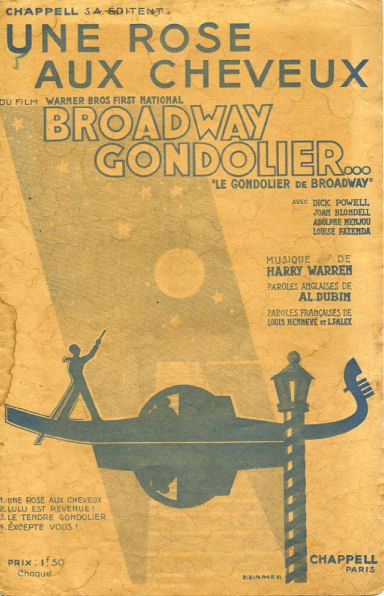 The actor playing Charles just plays Jeremy Irons playing Charles, the actor
playing Sebastian has the
ferrety face of a Cockney urchin* and Julia fails to outshine either of them.
The scene where Charles visits Sebastian in the Moroccan hospital is well
handled and genuinely moving, and so something of a rarity.
The actor playing Charles just plays Jeremy Irons playing Charles, the actor
playing Sebastian has the
ferrety face of a Cockney urchin* and Julia fails to outshine either of them.
The scene where Charles visits Sebastian in the Moroccan hospital is well
handled and genuinely moving, and so something of a rarity.
*With hindsight this was a little harsh on Ben Whishaw,
but he has come on a lot since, with some more suitable roles.
Broadway Gondolier 1935
This one's a musical starring Dick
Powell, Joan Blondell, Adolphe Menjou, and the Mills Brothers. Powell is
Dick Purcell, a cab driver who sings, in his cab, in traffic and so a
producer sets him up with an audition, which he blows, but becomes smitten
with a secretary there. played by Blondell. Following more preposterous plot
devices he becomes a gondolier and impresses a cheese heiress, who hires
him, changes his name to Ricardo Purcelli. He acquires a moustache and an
accent and a voice teacher, called Eduardo Da Vinci, played by Adolphe Menjou.
Entertaining tosh, it seems, and with no location filming, I imagine.
Le Cadeau (Bankers also
have Souls) 1982
The second title is how this was known
in the US - it was never released in the UK. It stars Pierre Mondy, a French
comedy actor whose fame hasn't travelled well, as a bank employee who gets
given a call-girl as a retirement gift. He doesn't realise, of course -
thinking that she's just attracted to him. (Dufour, his surname, gets
translated as Duffer in the subtitles.) They
travel to Venice and all sorts of hilarious misunderstanding ensues, we're
told, and a fair amount of hiding in wardrobes and falling into canals and
gondolas. I don't feel massively drawn to it, I confess, but I promise I will
watch it one day and report.
Canal Grande 1943
The story of a gondolier who sees the way things are going and becomes a
vaporetto pilot. Seemingly only ever released in Italy and Portugal.
Capriccio Veneziano
2002
An old fashioned soft-core porno film in which a beautiful young music student
arrives in Venice to study at the Venetian Academy of Music where, you
guessed it, her tutor, an artist, soon starts to teach her more than music. Directed by
Bruno Mattei, whose other works include Mondo Canibale, Women's Prison
Massacre, and SS Girls, here using the name Vincent Dawn,
which is one of his many aliases. He also directed Desire, also set
in Venice and also about a piano student. If the plot set-up makes you think of a
floppy-haired aesthete showing a sensuous but nervous dark-haired woman in
flat shoes the sexual ropes then good for you. It means you've not seen this
film, and are not au fait with the conventions on Planet Porn. Here the
'artist' has an astonishingly over-built body and no neck, making a scene
where he's beaten up by two stocky shrimps in gondolier shirts even more
ludicrous. And the sneery music student looks like she'd be more confident
teetering around Venice shopping for sparkly frocks than
teaching music to speccy girls. There's also a scene where the erotic cliché of the cello clasped between the knees is overblown muchly.
And I don't think she'd be able to use her bow again soon after putting it to the
use she does. There's plenty of Venice on show, including the actual Academy
of Music, and it just goes to show how location porn resembles the real
thing that I found myself wanting the camera to pan a bit to the left so,
for example, I could get a look at the long-covered façade of the
Accademia. I found this online, without English subtitles, but even though I
couldn't understand what they were saying, as I skipped through the video
file, I knew I wasn't missing much - the universal language of bad acting.
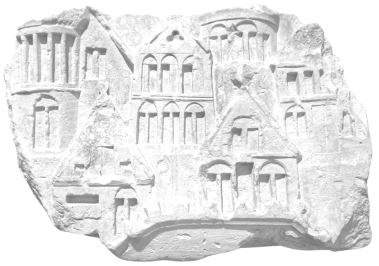
|
|
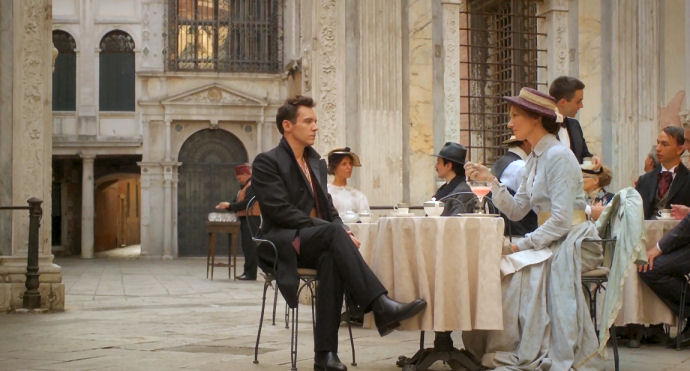
Two from The Aspern papers
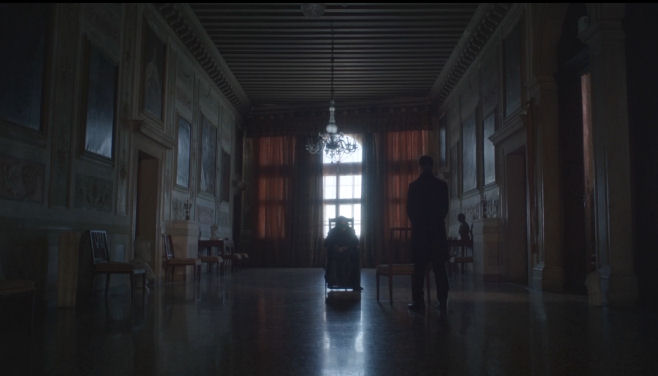
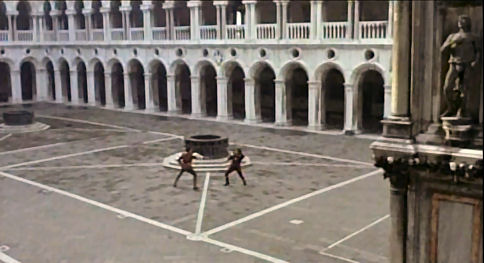
Avenger of Venice
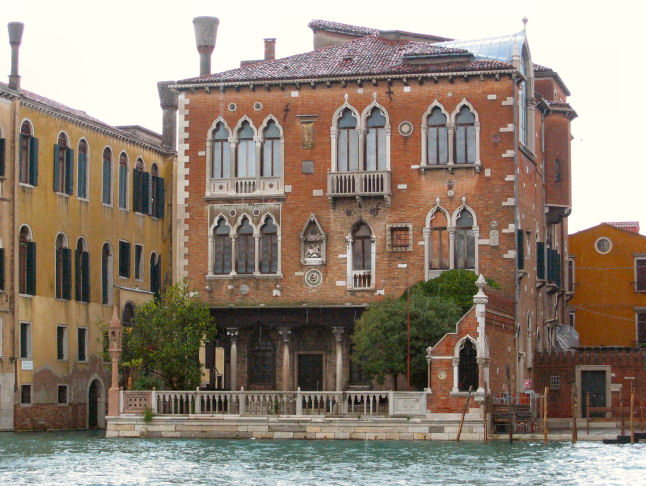
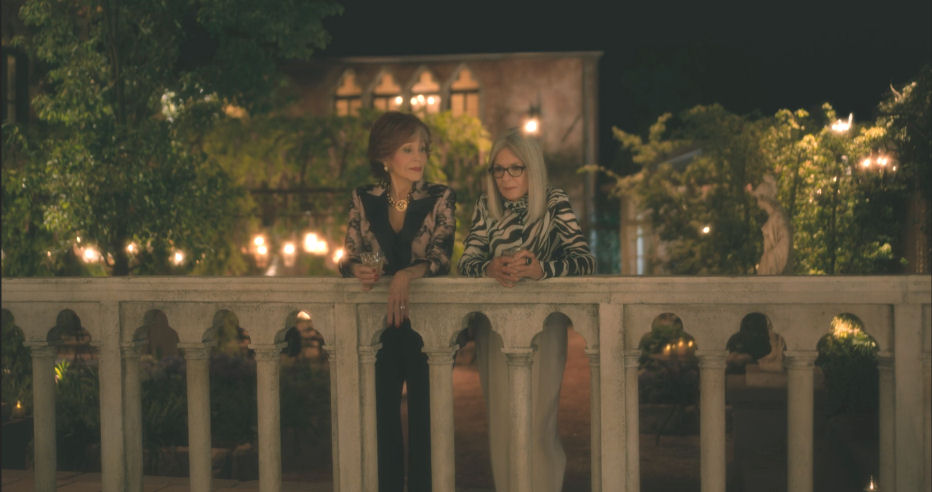
Book Club
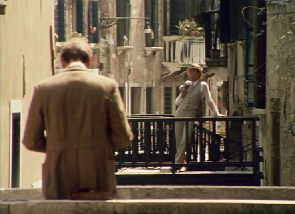
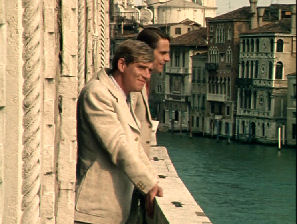
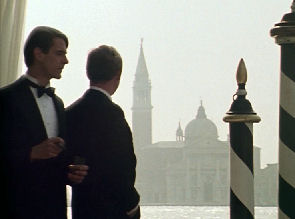
Three from Brideshead Revisited 1981
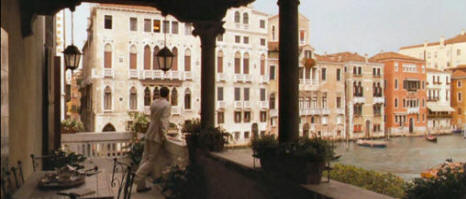
Brideshead Revisited
2008
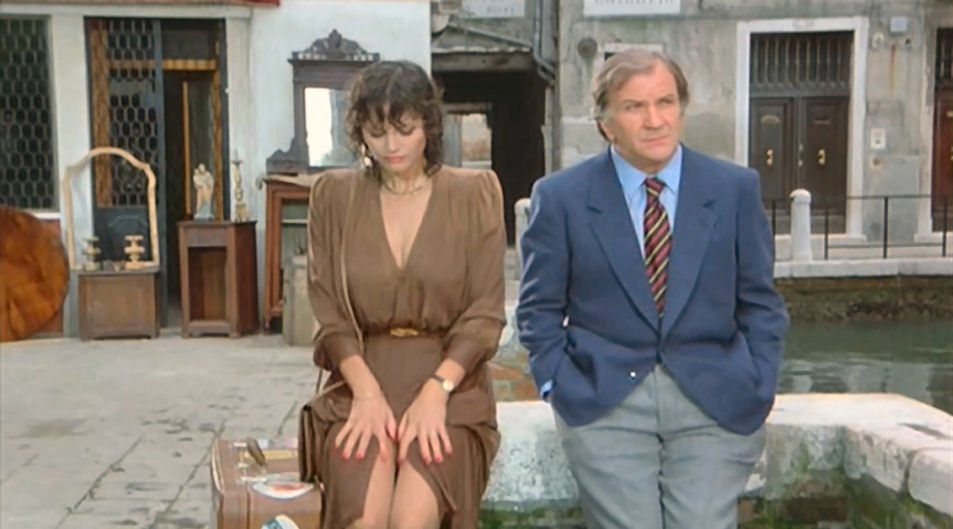
Le Cadeau
The Comfort of Strangers
1990
When I first saw this film I found it disturbing and
confusing, like the book, and didn't like it. Seventeen years on I watched
the DVD and liked it a lot more. It's still disturbing, if not quite as much
as back then, and I still don't know what it's supposed to be about. Natasha
Richardson and Rupert Everett play a callow and troubled couple on holiday
in Venice, trying to fix and/or understand their relationship, who fall into
the clutches of a psycho-couple played by Christopher Walken and Helen
Mirren. There's much atmospheric photography of Venice, by day and by night,
with repeated use of red-tinged mistiness at night, presumably meant to be suggestive of
hell. The book's setting was only implied as Venice, but here all is real and recognisable Venice, except for the palazzo interior
of the predatory couple's apartment, which looks like a stage set, maybe on
purpose. So it gives good Venice, and has an effectively evoked sense of
gathering threat, but it still confuses. I can see that there are post-80s
themes of freedom/bondage and liberality/repression going on here, but the
ending still does not bring clarity.
August 2020 update A new 4K remaster on
Criterion Blu-ray in the US is reportedly sparkling. But it's expensive,
and prohibitively expensive to ship to the UK too. But there is a UK Blu-ray
from 2018, which is pretty cheap and includes three archive films: The
Glass Makers of Murano (1928), Venice in War Time (1918),
and City Lights (1964). The last two are about the transportation
of munitions and coal respectively. Irresistable!
|
Casanova
films now have
their own page
Donna Leon's
Commissario Brunetti
the TV Series
now has its own page.
|
|
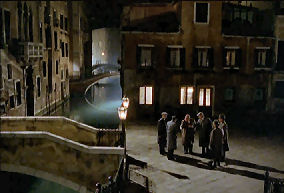 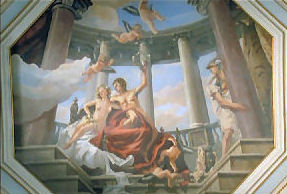 A Dance to the Music of Time
1997
A Dance to the Music of Time
1997
An excellent, if somewhat drastically shortened, BBC
television adaptation of Anthony Powell's 12-novel sequence dealing with
intersecting lives lived and dances danced through the major events of the
20th century. Simon Russell Beale's in it, and there are cameos from John
Gielgud, Alan Bennett, Zoe Wannamaker, Michael Williams and Miranda
Richardson. It gets to Venice in the last of the four episodes. The Venice
sequence, contained in the novel
Temporary Kings, is relatively lingered over and it's a good enough
palazzo-fix, with an imitation Tiepolo ceiling plot-device telling the same
story as Kristin Scott-Thomas told in The English Patient and
reflecting the episode's concentration on voyeurism and weird sex generally.
Along with much death and some masks, this all goes toward making it a very
Venetian experience.
Available on DVD from a few years back. |
|
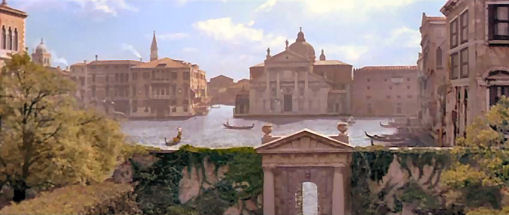
Anywhere you've ever visited? Two from
Dangerous Beauty
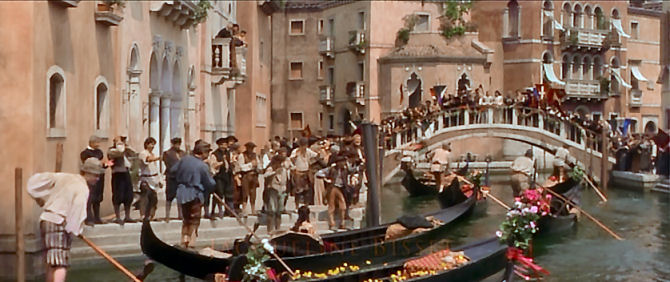
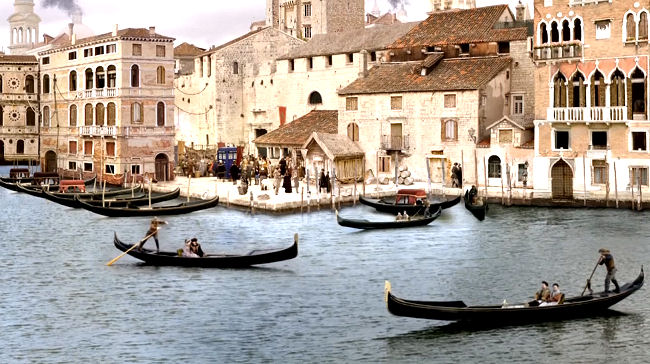
Two from
Dr Who - Vampires of Venice
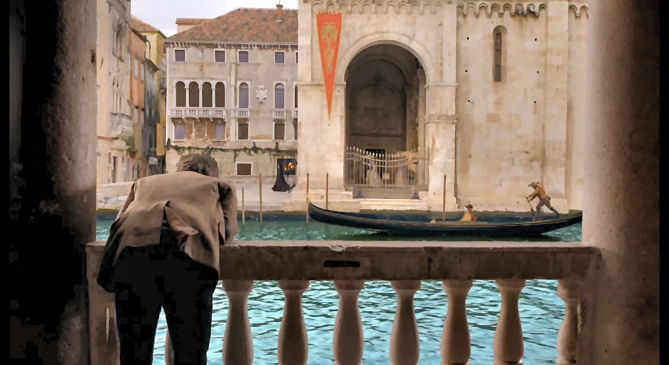
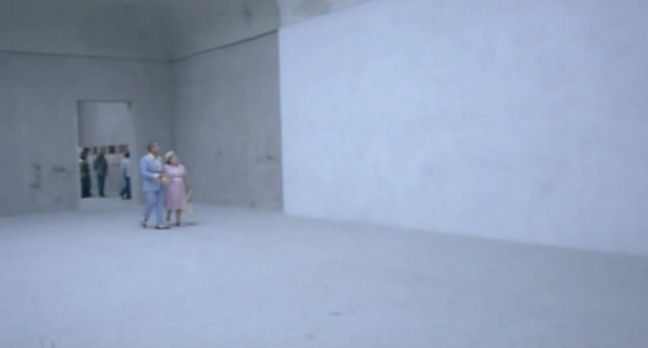
|
Dangerous Beauty
(aka The Honest Courtesan)
Based on the true story of Veronica Franco, a woman of wit
with few options open to her in 16th century Venice if she is to continue to develop her mind, and
her relationship with Marco Venier, a member of a patrician family with a
dynastic marriage planned for him. (He is played by a young Rufus Sewell,
who was later to
star as Michael Dibdin's Venetian detective Aurelio Zen in the BBC's TV
adaptations, and to appear in The Tourist.) So her Mother trains her in the family trade of high-class
courtesan, and she sets about bedding and besting the - unfailingly handsome
- men of Venice, and getting her poems published. Catherine McCormack
impresses as Veronica, the film holds the attention and Venice looks nicely
like Venice. True the wider views all look faked - more like a painting on
velvet than a Canaletto - and the canalside scenes seem to have been filmed on
the one set. The plotting and dialogue have some mundane patches too, but
overall it's an attractive film featuring some gently challenging sexual
politics. But you just know that when the films was being pitched the word
'feisty' featured a lot. The best scene has some important patrician wives, who lack
our heroine's access to the centre of things, summoning Veronica to tell
them of the fate of their men in the war with the Turk. One of them angrily
asks what she has that they don't, that their husbands are so smitten with
her, and she demonstrates, with a little Latin and a wicked way with a
banana.
The film is based on the standard work on
Veronica Franco, by Margaret Rosenthal, who also wrote
this page.
The Region 1 DVD has some notes on the cast and the story, and a very
trailerish trailer. It is also rumoured to be a full screen print trimmed
top and bottom to look like a wide screen version. And there is a cropped
look sometimes (see below left).
Death in Venice
Not a book I'd read, or a film I'd seen, before I bought the DVD. Dirk
Bogarde plays a composer haunted by death and failure who comes to Venice to
recover from an illness, only to find there's cholera on the wind. Staying
at a hotel on the Lido he becomes obsessed by a pretty boy, with whom he is
soon exchanging meaningful glances. The action, if pining and hesitating can
be called action, takes place mostly on the Lido, so there's not much Venice
flavour, indeed the camera seems mostly to wilfully exclude sweeping views
and full-on glimpses, but what little there is tends to be ravishing or
fragrant. The pace is stately, the hats are huge and the flashback arguments
with Alfred about the nature of art and beauty are laughably overwrought.
It's very much a film of its time and just about rewards your patience.
The DVD extras include Visconti's
Venice and Views of Venice, but these are an 8 minute
contemporary location report and a sequence of black and white stills
respectively. A bit of a con, in other words.
Desire 1990
Another porno film about a female music student, a pianist
this time, coming
to Venice, to compete in a piano competition this time, a plot it shares with Capriccio Veneziano
and the same director is responsible, this time using the alias Michael
Cardoso. It stars Josie Bissett (who went on to Melrose Place and a
TV movie called Baby Monitor: Sound of Fear), her shoulder pads, some TV and bit-part
actors and a voice coach. All of which just about guarantees you'll be
approaching this one with low expectations. Which is just as well. Nobody
can act, the plot is standard fare where our heroine gets involved with the
piano competition judge, a smoothy who provides her with emergency
accommodation, whilst simultaneously meeting and shagging a cute young
Venetian. The carnival, the Salute, and various wanderings provide Venetian
relief between sex in a palazzo, sex in a courtyard, and wooden acting
everywhere.
Doctor Who - The Vampires of Venice
2010
An episode from Season 5 of the recent reboot of
Doctor Who - the first season with Matt Smith as the Doctor - this is not the
first time the Doctor has visited Venice, but it's arguably the most
convincing. We still don't get any Venetian location filming, but the
computer-generated scenes do look mighty handsome. The plot concerns some
seeming vampires doing dastardly things to young girls in nightlines in Venice
in 1580. These vampires, mother and son, turn out to be not what they seem,
and an eco-disaster ensues, nearly. The interiors, streets, and courtyards mostly seem to be sets,
of a generically medieval or pseudo-gothic nature, or where maybe filmed in
crypty places and castles that were nearer to home, or cheaper to film in. Some wider exteriors look more
Venetian, but are very CG, which seems about par for this kind of mid-budget
series nowadays. Exciting and well-written stuff, though.
Dove vai in
vacanza? Where Are You Going on Holiday 1978
Three films in one. In the first a
dentist (played by veteran hunk Ugo Tognazzi of La Cage aux Folles
fame) visits his ex (played by veteran 'sex icon' Stefania Sandrelli) in the hope
of getting his end away. She's older and more feminist now and gives him the
run around to 'comic' effect, as more guests arrive and infest their holiday
home. Young people strum guitars, smoke funny cigarettes and show their
breasts, if female, and some basic liberal sexual politics get aired.
There's a
cheesy Ennio Morricone soundtrack too. In the second an ex-taxidermist
stranded in Africa by a slump in demand gets a job as the leader of wildlife
tours and gets mixed up with a rich man in need of a potency-boosting lion
trophy, and his wife (who wears tight leopard-skin) who needs her husband to
have a hunting accident. This one's a bit better, having some surreal
dialogue ('My legs were like two tuna') to offset the fart jokes and dusty
air of The Benny Hill Show. The third part Le vacanze intelligenti, directed by
and starring Alberto Sordi, concerns a couple of fruit sellers
whose stuck-up children send them off on a trip through Italy to broaden
their minds and lose weight. Etruscan tombs are followed by a short (seconds
of location filming) stay in Florence to get befuddled by modern music and a
longer visit to Venice. Here they take a gondola ride, an extended tour of the 1978
Biennale to get befuddled by modern art, and break their diet with piles of
pasta, sausage and beans as a
spectacular two-fingers to their children. On returning to Rome they find
their house turned into a modern interiors magazine nightmare, but it all ends
with them comfortably back at work, slaving to pay for the educations of
their tedious children, and all boisterous and happy. This last
episode has more maturity and charm, and no gratuitous nudity, but still no
real point.
|
|
Don't Look Now
|
Dark Venice comes convincingly to the screen. A film full of
70s spookiness and sex, it keeps you disturbed and unsettled from
beginning to end. This is set in the real and misty and cold out-of-season Venice,
rather than the warm and glowing high-season version, with plenty of torn
posters and rubbish sacks. Also good for scenes of Venice by night. And
the occasional location liberties are balanced by scenes which display
almost pedantic geographical accuracy. The
famous love scene was filmed in the
Hotel Bauer Grünwald and the film loses its heart without it, as was
proven by the version the BBC broadcast years ago with the scene cut out.
This is not just one of the best films made in Venice, it's a great film
made in Venice, and probably Nicholas Roeg's best film. The church which Donald Sutherland is
restoring is San Nicolo dei Mendicoli over in Dorsoduro, out by the docks,
which actually was being restored by Venice in Peril at the time of filming.
July 2019 saw the release of a 4K restoration
on Blu-ray. It keeps the extras from previous releases. The highlight then
was
a short and quite enlightening documentary, the disappointment a
rambling and frustratingly thin commentary by the director. The new thing
was a
pointless compressed version of the whole film made by Danny Boyle.
For the 2019 release there are three new documentaries - one on the film,
one on its use of colour and one on the restoration.
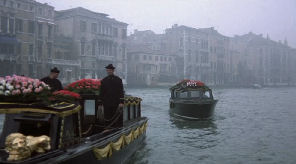
|
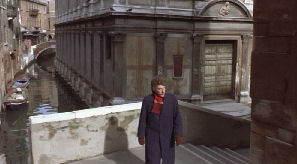
The Miracoli church sure did need cleaning!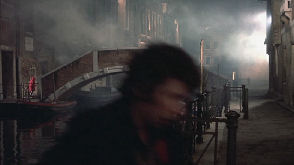
|
|
Effie Gray
After many years of delays, legal and production-related,
Effie Gray finally appeared in 2014, and lo it was deemed to be OK. The casting
changed over the years, and another writer said that Emma Thompson had
nicked his idea. The fact that this idea was based on a true story makes
this challenge seem nonsense, of course. The story is of John Ruskin
marrying a much younger woman and then not having sex with her. She then
divorces him based on his impotence, and shacks up with the artist Millais.
The film stops short of the court case, and is hence really only about the
marriage. Effie is sweet and intelligent, Millais is confused and then
smitten, and Ruskin is a heartless mother-smothered bastard. The story
isn't dumbed down exactly but it's also not stuffed full of nuance. A
scene where Effie tries to relate Ruskin's ideas on the architecture of
Venice to his feelings for her has a bit of frisson going for it, but art
is not really the subject here. The pair get married with a backdrop of
snow falling, and then everything is cool and rainy and blue-coloured from
then on. It rains, mostly, their home is all blue tones inside, they go
and stay in Scotland and it's all misty and rainy and the cottage interior
is all...blue and cool. You get the (blue) picture? Venice features for
about 20 minutes, and it looks lovely in a well-lit widescreen way.
Locations used are mostly pretty canals, views from palazzi and
some (love)
action that leaps geographically inauthentically from the Doge's Palace to the Miracoli
church and the
alleys between the Palazzo Barbaro and the music conservatory. Also a
picturesque courtyard - the one where Effie does a Busby Berkeley - that I
didn't recognise. (Since identified as the Conservatorio Benedetto
Marcello - thanks to Jonathan) London locations include Osterley House and the
ubiquitous Greenwich Naval College. Not insulting, then, but not
challenging. Not unenjoyable, but not unpredictable.
Emanuelle in America
1977
Some films dealt with on this page have so little going for them that the
Venetian setting is the main appeal. This film is infamous for so many
reasons that the partial Venetian setting pales into almost humourous
unimportance. It was directed by Joe D'Amato, yet another Italian creator
of films full of mutilation, horror and nasty things happening to naked
women. It features Laura Gemser, the star of the Black Emanuelle series
(she's actually Indonesian) as a photojournalist from New York on the
trail of a good story that also features women getting naked. (You'll note
that she's Emanuelle with one M, presumably to head off legal action.)
Along the way she gets to investigate a rich man's harem and a rich
women's equivalent, observe a young woman practicing horse masturbation
and observe and film, and participate in, much sex, orgies etc. But
hers isn't the unsimulated stuff the film is renowned for. And then
there's the snuff films. You can see why this film has a certain
reputation. But the Venice-set scenes are fun! There's the usual
geographically-impossible gondola ride, a palazzo that seems to move up
and down the Grand Canal depending on which window you look out of, and
some 'action' in the Benedetto Marcello Conservatory of Music, a location
strangely beloved of makers of porn films in Venice. We spend about 20
minutes in Venice, and I confess I've only sample-watched. You don't pay
me enough to watch the whole thing.
Emmanuelle in Venice
1993
Features Marcella Walerstein as young Emmanuelle, with
ex-Bond George Lazenby and the original Emmanuelle Sylvia Kristel
as Old Emmanuelle, which suggests a very Venetian theme of aging and
decay. Well no, it's actually about old Emmanuelle flashing back, as it
were, to when she helped a young widow overcome her misery and her
mother-in-law. She does this using her special mystic-sexual powers, so that she just has to touch a charmed liquid to the cleft
between her naked breasts, which results in lightning striking, and the
widow goes all peculiar and immediately becomes a better and sexier
person. She shows this by stopping whipping her maid and instead teaching
her the ways of lesbian sex, and then taking her to Paris to go shopping
and eat ice cream. I know, how far-fetched is that - she lives in Venice and goes to Paris for ice
cream!? This is probably as far as I'm going to go
in my dedication to watching all the Venice-set films I can get my hands
on. It was very cheap, but still. The Venice exteriors are pretty much
stock shots taken from boats on canals and the interiors are
semi-convincing sets. But Venice is just a source of bits of business to
intersperse between the tedious plot and the soft-core porn, of course,
which is pretty much your standard dry, panting stuff. The only joy being
admiring quaint details like, for example, some frantic copulation
featuring a chap still glimpsably wearing his underpants. Clever.
Les Enfants du
Siècle (Children of the Century)
1999 Diane Kurys
A film about the French writer George Sand's tempestuous relationship
with Alfred de Musset. Juliette Binoche plays Sand and Benoit
Magimel plays de Musset. (The pair began a four-year relationship whilst
making this film.) It's an admirable if not, for me, lovable film. And a
bit long at 137 minutes on the DVD - the original
French theatrical length. The story, of a strong older woman's devotion to an
unworthy young wastrel, is not particularly original but is done well enough.
The middle 40 minutes gives good Venice. Some odd angles are used,
presumably to exclude vaporetti and intrusive modern details, but this
film does a fine job of conjuring up Austrian-occupied Venice, with its
covered-in gondolas and infestation of uniforms. And evidently the rooms
in the Danieli where the couple stayed are the ones used in the film,
although the orangey façade of the Palazzo Pisani Moretta stands in for
exterior shots. There's also a scene of de Musset pissed in the rain
at the film-favourite location by Santa Maria Valverde.
Eva
(Eve - UK title) 1962 Joseph Losey
Misery and misanthropy from Joseph
Losey as Stanley Baker plays an arrogant working class Welsh lad made good
(of course, this film was made in the 60's) whose first novel gets made
into a film, which puts him in a black and white Venice for the film
festival. He stays on and buys a house on Torcello, which is invaded one
wet night by tart-with-no-heart Jeanne Moreau. His obsession with her
threatens his relationship with his film's director's assistant, amidst
recriminations, revelations and, yes, a gondola funeral. A dated film, to
be sure, in its self-conscious 'European' artiness, jazzy soundtrack and
rather obvious imagery. But Venice looks fine in the winter and the story,
from a James Hadley Chase novel originally set in America, keeps you interested, just about.
Everyone says I love you 1996 Woody Allen
You need to be able to cope with the whole
musicals suspension-of-disbelief thing to appreciate this one. Also the
way that Woody's blotted his copybook in recent years - personally and
professionally - has to not affect you. And the fact that his whole shtick
was starting to wear a bit thin at this stage. But apart from that...it's
still not a very good film. The plot concerns a family of rich New Yorkers
and their various interconnected love-life difficulties. Julia Roberts and Goldie Hawn acquit
themselves fine, but the dialogue and the musical numbers just lack
much conviction and any spark. Thirty minutes in there's a fifteen-minute
Venice episode, which is why I'm writing this of course. Julia R. jogs
around Dorsoduro and through Campo Santo Stefano, meeting Woody in Campiello Barbaro
(see right). There's some standard fish market
action, and a hotel terrace opposite the Salute. Tintoretto is a plot device, as is a visit to the San Rocco
Scuola, and then it's back to New York. Not a long Venice fix, then, and not a good
film.
Executioner of Venice (Il boia di Venezia) 1963
In 17th-century Venice the Grand Inquisitor is hatching plots to usurp the
doge, even including the arrest of the doge's son as he's about to be
married, in San Giorgio Maggiore. The ensuing shenanigans feature much
political jiggery-pokery, lots of pirates, and the buckling of many
swashes. It's an attempt at one of those hands-on-hips swaggering
swordfests like Errol Flynn used to star in, and it doesn't make a bad
fist of it, despite its low budget. The doge's son is played by Lex
Barker, famous for playing Tarzan a decade previously, and the villainous
Inquisitor is played by Guy Madison, famous for playing Wild Bill Hickok a
lot in the same period. This film was made in Italy, and the dialogue is
dubbed in the English version and can get a bit ripe, but is often also
surprisingly witty. The acting is variable too, but far from unbearable.
There's massed swordfights on Torcello, in front of Santa Fosca, and in
the Doge's Palace courtyard. The heroes are the poor and downtrodden
masses, who live on Giudecca, described as a den of wickedness and
lawlessness but looking a lot like the Rialto fish market to me. Some
filming in front of Santa Maria Valverde too, a favourite spot of so many
film makers, being picturesque but off the beaten track. Not bad at all.
The DVD I managed to find and buy online is a pretty
low-quality copy of a VHS tape, badly pan-and-scanned and probably
recorded from a television broadcast long long ago.
A Few Days in September 2007
A CIA agent (Nick Nolte) has knowledge of impending
terrorist attacks and so needs to get his daughter, his son, and a French
woman he once worked with (Juliette Binoche) to meet him in Venice. They
are pursued by a 'poetic psycho' played by John Turturro. They all meet up
on September 11th 2001. The reviews weren't great, and so my expectations
were modest, but this wasn't as bad as I'd dreaded, just not as good as it
thinks it is. The dialogue is quite sharp, the photography too tricksy,
and the performances mixed. Juliette B has fun playing the ex-foxy agent
whose best pals are her gun and her tortoise, but Turturro's bonkers
psycho, who kills indiscriminately and then rings his shrink on his
mobile, is more than a little unoriginal. Overall the film's plotting is
just not that fresh. The last hour is all set in Venice, though, and the
setting is dealt with in an unshowy and 'real' way. No cliché Salute shots, no
predictable scenes in San Marco, just recognisable and evocative wanderings and views.
And what did happen to the tortoise?
Il Fornaretto di Venezia
1963 (US TV title: The Scapegoat)
A play written in 1846 by Francesco Dall'Ongaro
and also filmed in 1939 and 1952. Directed by Duccio Tessari who co-wrote
the screenplay with Marcello Fondato, it's set in the 16th century and tells the story of a
working-class lad, a baker, sentenced to death for attacking a noble. It
stars Jacques Perrin, Michele Morgan and Sylva Koscina, and reportedly
gives good Venice.
The Garden of Earthly Delights 2004
As 2018 dawns the number of films set in Venice
which remain to be discovered dwindles. The good news about this one is
that it's very concerned with art, and Hieronymus Bosch in particular,
unsurprisingly, given the title, although a bit unusually. The downside is that it's
centrally about someone going to Venice to die, which is a bit of a
cliché, and it looks very handheld, shaky and arty. The director is Lech
Majewski, who also made The Mill and the Cross, which is basically
a - reportedly plotless - film set inside The Way to Calvary,
another Bosch painting. We'll see.
Giallo a Venezia 1979
The giallo as a literary genre is pretty much
synonymous with the hard-boiled crime thriller. When the term is applied
to film you're in for something a bit more juicy. So this one begins with
a couple found dead on Giudecca - she's drowned
and he's been stabbed in the goolies, repeatedly. A story unfolds of the
depraved acts the husband had forced the wife to suffer, and we get to
watch them all in flashback, in detail. So it's basically porn
bookended with a murder, and with some more gruesome murders in between.
To add spice there's a detective who's 'thing' is eating hard-boiled eggs. And some voyeurism in a boatyard involving a spooky
Kevin Keegan lookalike. (The tragic 70's hairstyles and 'taches are a
feature in themselves.) There's a fair amount of Venetian location action
too - mostly ordinary, not to say dull, but one short scene was filmed
near the Stucky mill - now a luxury hotel - when it was a building site. I can't really recommend
this film, to Venice fans or to sensitive types, but if you have a strong
stomach and want to see what the giallo genre has to offer I suppose you
could do worse. But you'd have to try very hard.
The releasing of this kinda stuff is erratic and
short-term, it seems. I bought it as an
'unofficial' copy from an online supplier. It looked to have been copied
from a manky old VHS tape and the image was cropped square
from the widescreen original. An American company
called Code Red released it on Blu-ray in 2016; and in August 2018 it came
out on Blu-ray in the UK, courtesy of Scorpion Releasing, with a
commentary by a film historian, even.
Gloria 2024
I've so far only found this in its original
Italian with French subtitles.
It looks to be about orphan girls and music, inspired by the Pieta girls
but not looking very Venetian in setting. Skipping through and sampling it
seems a well-filmed film, with atmosphere and little false glamour.
Reports suggest it is anachronistic and slow and the plot sounds very
tortuous and strange. Maybe odd enough to warrant a look when the English
subtitles turn up?
|
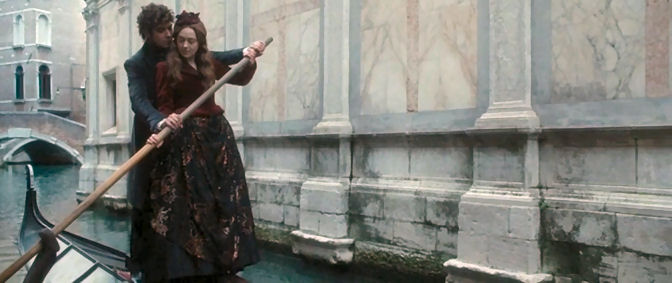
From Effie Gray
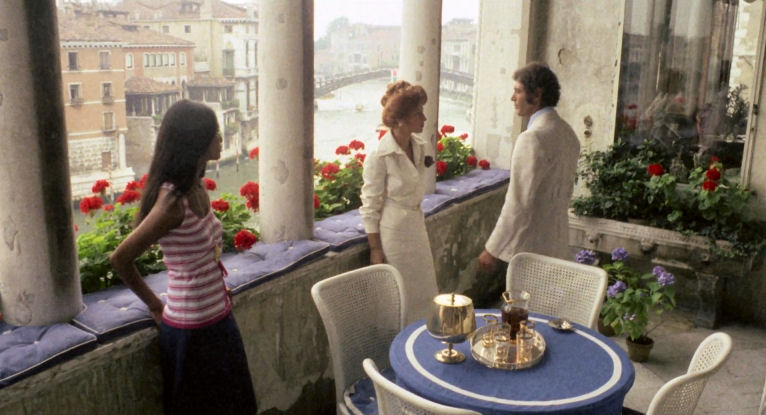
Two from Emanuelle in America
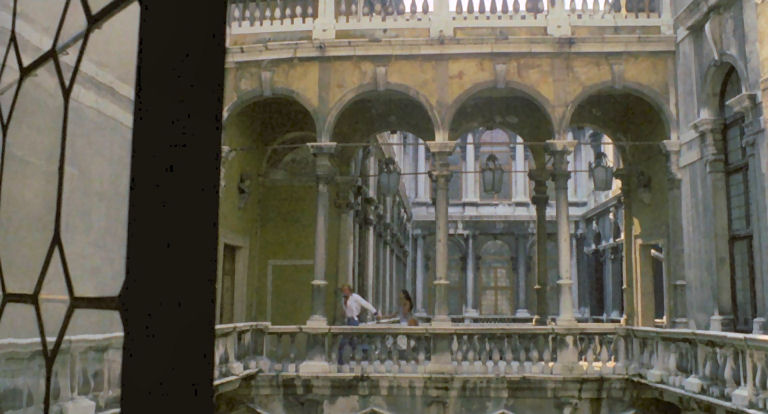
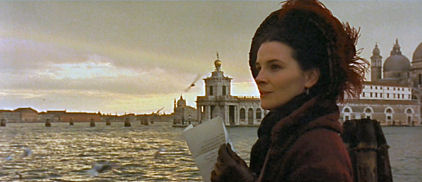
Two from Children of the Century
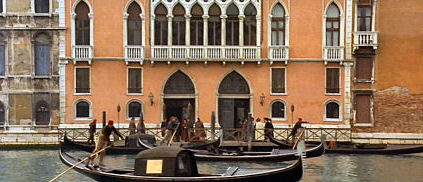
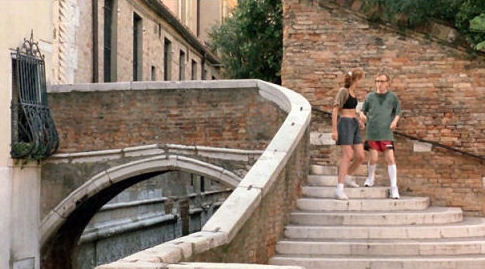
Two from Everyone says I love you
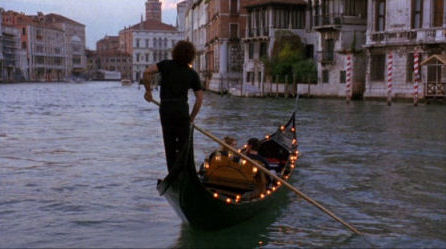
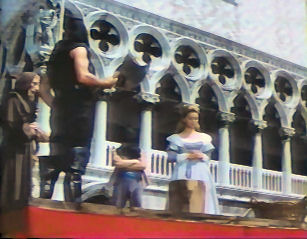
Two from Executioner of Venice
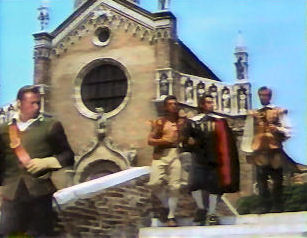
|
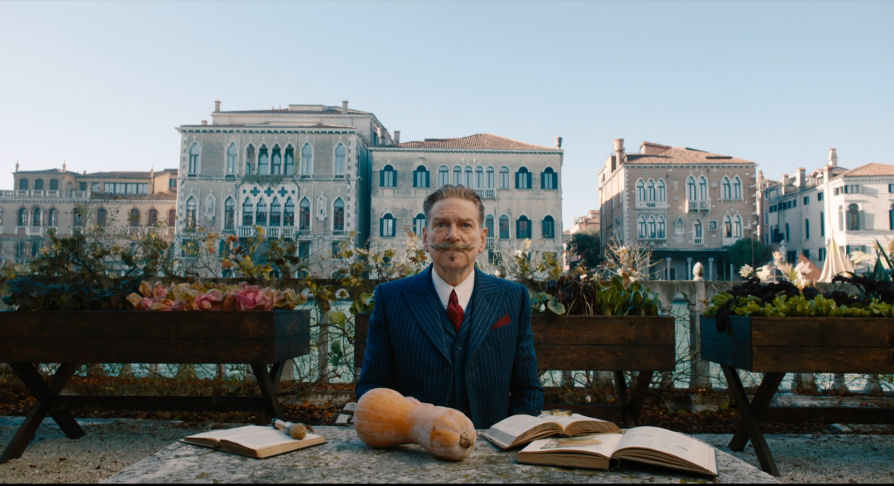
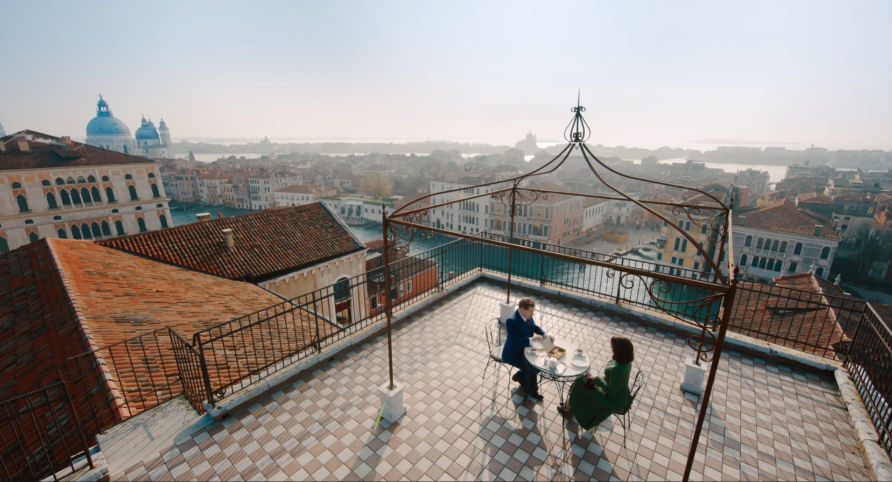 |
A Haunting in Venice 2023 Kenneth
Branagh
Not being a big Branagh fan, and the trailer being so crash-bang, I had low
expectations for this one, but it's actually pretty clever. It's based on
Hallowe'en Party, a lesser Agatha Christie novel set originally in England
in the 1960s, and transferred to Venice with much plot-changing and added
horror-film elements. The setting is now 1947, which adds plot depths, and the
consequent look is handsome and expected. Most of the Venice location
filming is in the establishing five minutes. Poirot's palazzo is consistent in
its location and views out of windows (even if his garden is a good way up the
GC) but the walks and boats around town take the usual topographic liberties. Tilting
cameras and wide angle views dominate, but it's good to see some style rather
than plainness. The action takes place in the Palazzo San Boldo, made daunting
by low viewpoints and the CGI embellishments to the stumpy attached
campanile of the lost church. The interiors overdo the Gothic and the ruination,
but I love that stuff! And as the plot involves a séance, several murders, a
Halloween party, the plague and the ghosts of dead children the lighting needs to be low
and the weather wet. There are shocks and twists aplenty and it's all
faultlessly Venetian. Well, there is one of those plot-necessary basements that
Venice doesn't have, but discovering lost dungeons at ground level just doesn't
do it, I suppose.
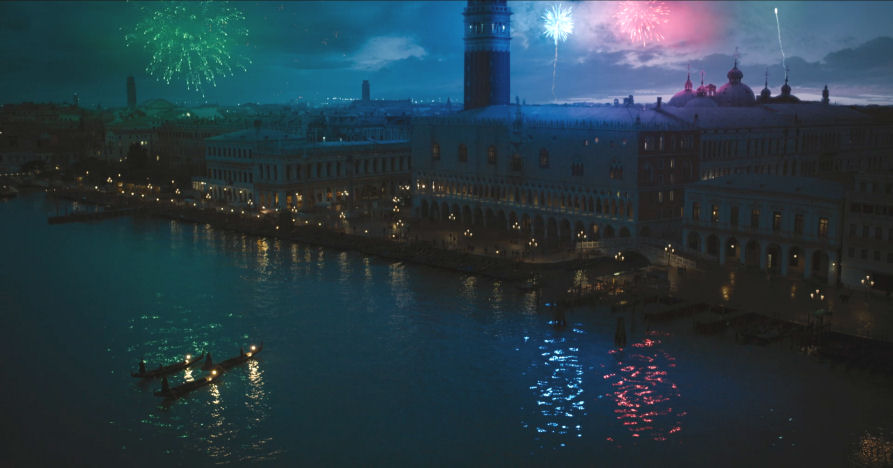 |
|
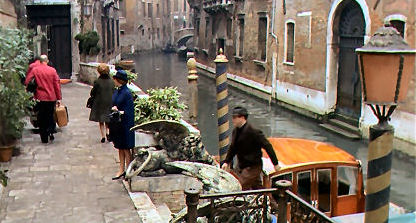
Two from The Honey Pot
featuring
the exterior of the Palazzo van Axel.
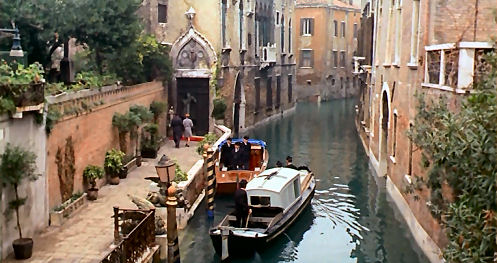
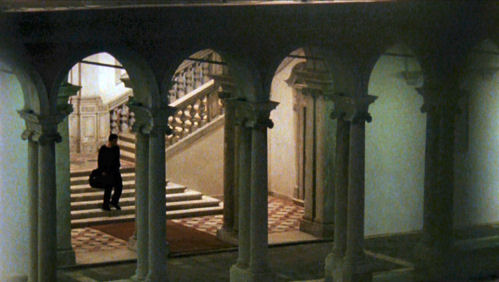
One from In memoria di me.
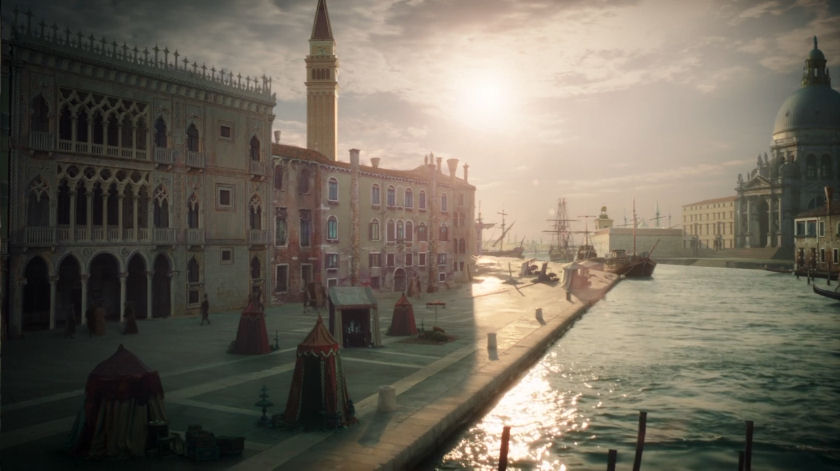
Two from Jonathan
Strange & Mr Norrell
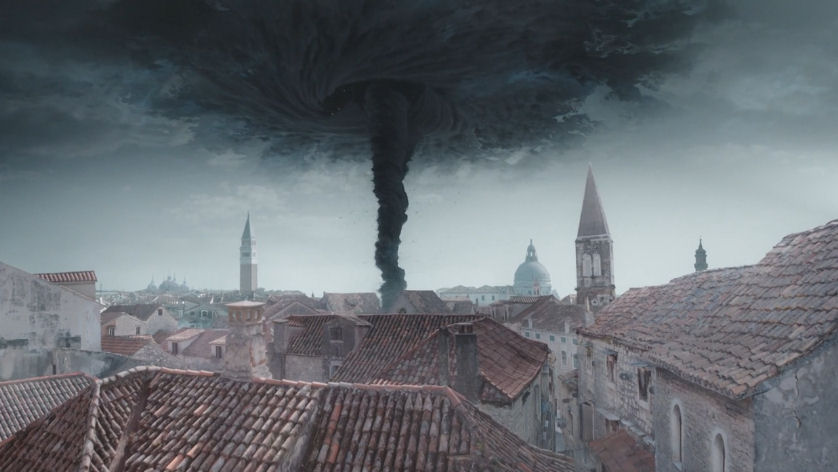
|
The Honey Pot 1967 Joseph L. Mankiewicz
(aka Mr Fox of Venice)
Rex Harrison plays millionaire Cecil Fox, who goes to see a
performance of Ben Johnson's Volpone at the Fenice and gets an idea. He writes
to three of his ex-mistresses telling them that he's dying, and invites them to
his palazzo in Venice with the promise of inheriting his vast wealth. (In the
book that the film is based on, Thomas Sterling's The Evil of the Day,
two of the inheritance-hopefuls are men.) Susan Hayward, Capucine and Edie Adams
play the old girlfriends, with Adolfo Celi as the policeman needed later on. This is quite a
clever, but wordy, film with lots of long stretches of dialogue in rooms
betraying its theatrical derivation. The rooms and garden are obvious sets
(built at Cinecittà in Rome) but the interiors looks so Venetian they are almost
too Venetian, with their brustolon figures and bits of Veronese. There is some location filming. The approach to the Palazzo van Axel, near the Miracoli church, is made to look like a private calle with the addition of a
couple of dozing gilt lions and some plants (see left). There's some
walking around at night in front of San Zanipolo, taking of tea in one of the San Marco cafes, and
nocturnal gondola-taking. Nice to see Maggie Smith in an
early and vaguely sexy role, and a considerable one too. An enjoyable film, it's
witty rather than humourous with a satisfyingly
twisty plot and with time and deception as its two most Venetian
plot concerns. This film comes in many possible lengths, with the director said
to be most unhappy with the heavily cut version that the studio released. At one stage this was going to be called Anyone for Venice?
No, really.
The Honeymoon 2022
A couple's honeymoon in Venice is gatecrashed by the
groom's best friend. The trailer features said friend having gross eating habits
and his slapstick clumsiness leading them into slapstick drug smuggling. Can it
be as bad as it looks? By all accounts yes.
Identificazione di una Donna
1982 Antonioni
(aka
Indentification of a Woman)
About five minutes of Venice towards the end, mostly in a hotel, but the Salute is
seen in the background, of course, as they arrive. Otherwise one of those films
where the characters do unlikely things whilst spouting unconvincing
pseudo-philosophical gibberish. Looks good though. Mostly set in Rome.
In Love and War 1996 Richard Attenborough
The adventures of the young Ernest Hemingway (played by Chris
O'Donnell) in Italy during WWI leave him injured and put him in a nearby
hospital run by American volunteer nurses. A
still on the imdb features his nurse/love-interest Sandra Bullock posing
on the Palazzo Barbaro balcony just like the lads in the Brideshead still
above, but it's deceptive, as there's very little Venice here - about three
scenes taking up less than a minute. It's an old-fashioned film heavy on
horrors-of-war and with no small amount of gore, but the uniforms and laundry
are mostly kept spotless and the emotions rarely other than black-and-white.
In memory of me
(In memoria di me) 2007
Now I'm the first to condemn shallow action films where
nothing much happens in a fast-edited blur, but at the other end of the
scale...the pace of this film demands patience, but it also rewards it. The
'action' concerns a group of men training for the priesthood and how the
solitude and group dynamic affects them and their beliefs. It's as dense a film
as it sounds, with many static (but beautiful) shots of corridors and cloisters,
but the craft and the commitment shine through. The Venice interest is that the
monastic surroundings are filmed in the ex-monastery on the island of San
Giorgio Maggiore, and in the church itself; and very handsome they look too,
especially at night, with atmospheric lighting. There's no filming in Venice
itself, but the DVD contains a very enlightening 'Making of...'
documentary which does give a lot more Venice. Two questions, though. Why the
jarring Strauss music on the soundtrack and in the refractory? And one of the
silhouetted figures walking mysteriously about at night is obviously a young
woman. How? Why?
Infanzia, vocazione e prime esperienze di
Giacomo Casanova, veneziano (The Childhood, Vocation and First Experiences of
Giacomo Casanova, Venetian) 1969
Casanova
now has
his own page
Jonathan Strange & Mr Norrell
2015
Based on a book I'd tried to read a few times, but
never gotten further than tens of pages in, the TV series is a treat.
Performances and appearances are both impressive, making for a soundly gothic
and involving experience. One of the reasons I'd tried to read the book, whose
plot concerns attempts to re-introduce ancient magic into 18th century London,
is the fact that said plot moves to Venice later in the book, when Mr Strange
goes and visits a dusty Venetian version of the Mad Cat Lady from The Simpsons.
On TV this Venice appears in episode 6 and is a thing of CGI panoramas (see
left) and sets standing in for vaguely Italian rooms, alleys and campi, albeit ones
benefiting from the series' superior design standards, with lots of tents
and marquees for some reason. These sets are sorely lacking in canals, as is often the
case in TV versions of Venice, presumably because filling studios with water
cannot be done easily and cheaply.
Laguna (Vendetta) 2001
An Italian/Canadian production only ever
released in Italy and available (inexpensively) on DVD from France (with
embedded French subtitles) where it's
called Vendetta. (In the introductory credits to the film it's
confusingly called Hotel Laguna.) It stars Joe Mantegna, Henry Cavill, Emmanuelle Seigner
and Charles Aznavour. Cavill isn't actually listed on the front of the DVD box,
but this is his film - he plays the son of a musician whose pals have sworn to
protect him from the Mafia boss who had his whole family blown up. He is now a
man and is sent to help one of said pals (played by Joe Mantegna) to run his hotel
in Venice. The hotel is actually run by the wife, who treats our hero coldly,
but is it because she secretly loves him? Well, I won't plot-spoil, except to
say that this is a film that has few surprises, plot wise, and has acting and
dialogue worthy of a porn film. Cavill gets to take his shirt off a
lot, and to get it taken off for him. He is asked to follow the wife by
the suspicious husband, a task made doubly difficult by her ability to magically transport
herself all over Venice, like disappearing from Giudecca and appearing by the
San Trovaso boatyard in the blink of an eye. An odd number of scenes are set
in the dock-like parts of San Giorgio too, including a sex scene up one of those
stubby lighthouse towers (see below). The hotel is over by the Arsenale, and in one scene a
sick man has been plonked in a picturesque chair out on the riva looking over the lagoon, with
his drink, his book and a pile of bubble-packed tablets - not something you'd do
to a sick man unless you had a team of wranglers holding back the crowds of tourists that
usually swarm along there. If I've said it once...I watch these films so you don't
have to.
 |
|
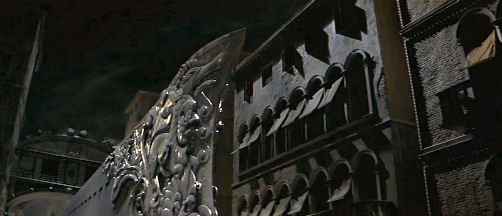
from The L of E G
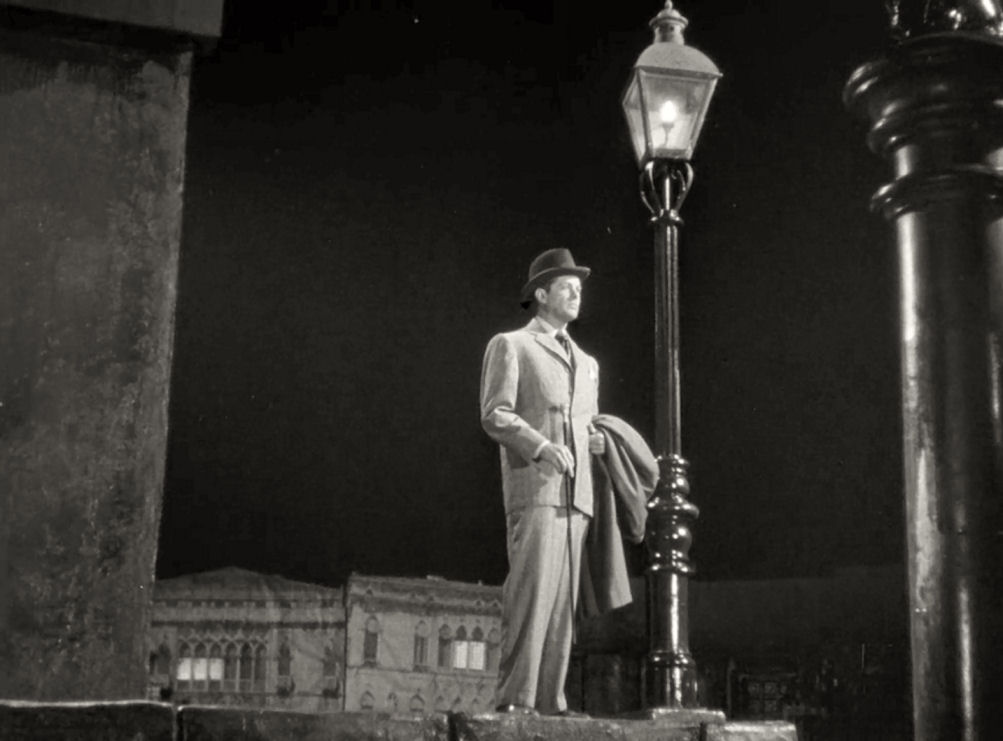
from The Lost Moment
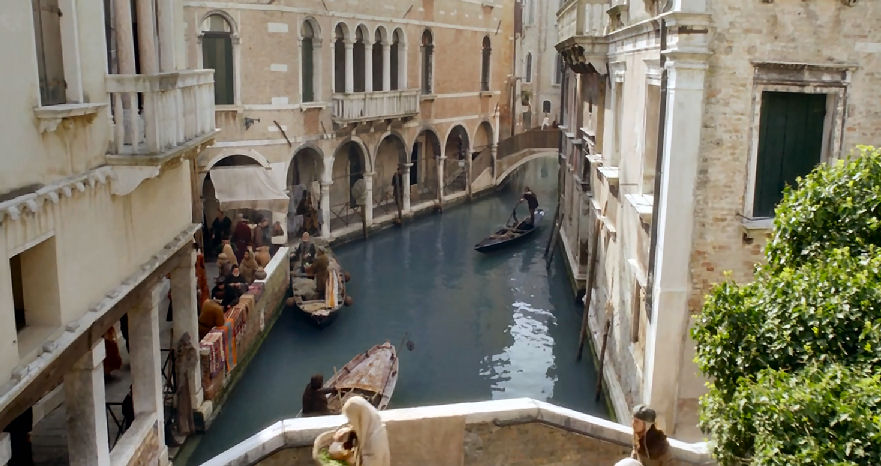
Two from Marco Polo
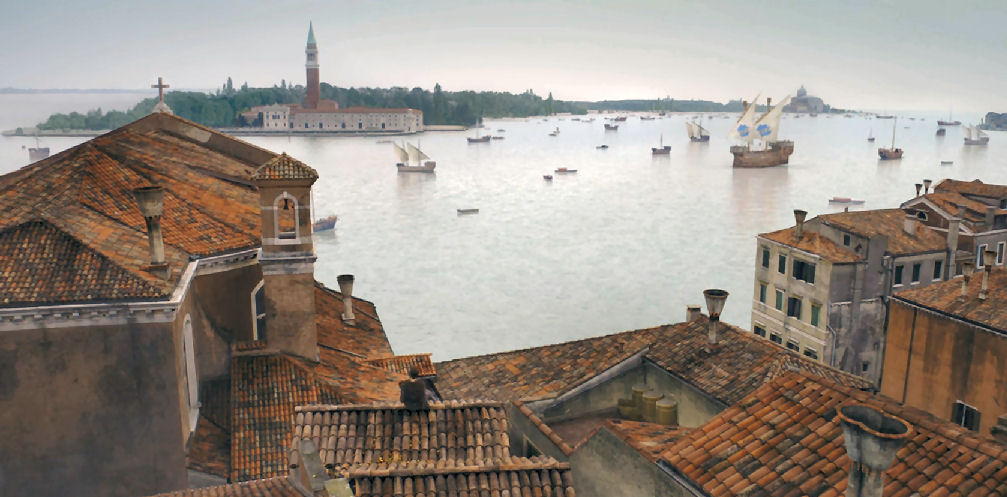
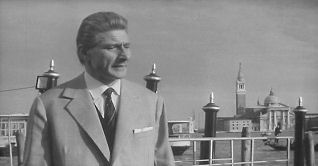
Two from Monster of Venice
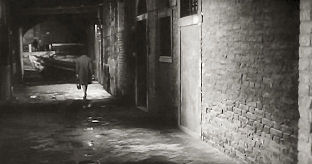
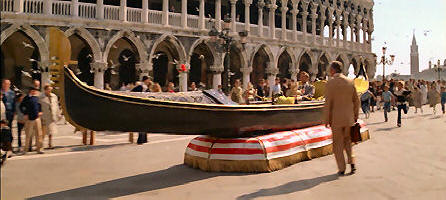
Three from Moonraker
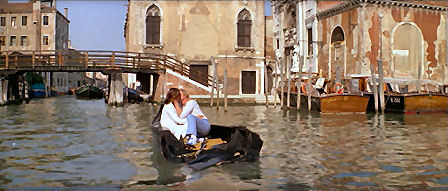
A speedboat has just chopped the obliviously snogging
couple's
gondola in half, you see.
|
The League of Extraordinary Gentlemen
2003
In which various characters from fantastic Victorian fiction do battle with
unspeakable evil. The first of the film's fiendish plots involves the
destruction of Venice, achieved by placing bombs in the looming and ornate
catacombs beneath the city. These catacombs don't exist of course, and so
neither do Leonardo's drawings of them, obviously. Other liberties taken
with Venetian reality are the bridges over the canals being four stories up,
to facilitate the passing of huge baroque-detailed submarines
(see left) and the car-wide streets of Venice to facilitate car chases
involving a large matching baroquely-detailed car. Despite these inventions
it's all handsomely done and this adaptation of a smart graphic novel is not
half as disappointing as reported.
Letter from Venice (original title: Unguided
Tour) 1983
'A couple on the verge of breaking up moves through a
hallucinatory Venice' we are told. Directed by Susan Sontag and starring two
actors that haven't done much else. Probably more than a little arty.
A Little Romance 1979 George Roy Hill
An educated middle-class American girl living in Paris
with her parents meets a street-wise boy with a cab-driver father. They
travel to Italy to seal their relationship with a kiss by the Bridge of
Sighs. The boy is played by Thelonious Bernard, who only made one more film,
has the same birthday as me, and is now a dentist in Nantes; the girl was
played by Diane Lane at the age of 14. Laurence Olivier and Sally Kellerman
appear too.
The Lost Moment 1947
A somewhat loose and Hollywoodish adaptation of Henry James' The Aspern Papers,
this stars Robert Cummings,
Susan Hayward and Agnes Moorhead. Cummings plays the publisher who worms his
way into the palazzo of an old woman (played, in deep shadow, by Moorhead)
who once loved a famous poet and so might have some very desirable letters. Susan Hayward glowers and sparkles as Tina, the suspicious niece who
has trouble separating the lifeless present from her aunt's lively past. The
plot progresses more in the style of Edgar Allen Poe than
Henry James - all gothic romance and deep shadows. Venice is well-evoked but
totally fake - sets and painted backdrops stand in for the rare exteriors
and the palazzo interior set, where most of the action takes place, is not
very Venetian but does loom and twist well with much wrought iron and many
odd corners and lost rooms. But Venetian inauthenticity aside this is a
well-made and acted bit of gothic romance and well worth a watch.
Released on Blu-ray in the US in 2014, and looking
much better.
Lovejoy - Death and Venice
1986
I'll admit I didn't watch any of this TV series at the time: it, and
Ian McShane its star, just never appealed. But I may have to admit,
20-odd years on, that I made a mistake. On the strength of this two-part
story from series 1 it seems to have been pretty sharply written and
humourous in an appealingly low-key way. Also, spookily, the first episode of
this pair was first aired one day after my birthday in 1986. It sees shady
antiques dealer Lovejoy getting mixed up in a cartel of greedy rich bastards
and their plan to own Venice, one artwork at a time. It gives great Venice,
albeit with 1980s low-res 4:3 VT quality. There's a lot of filming around
Campo Sant'Angelo and a scene in front of the Misericordia church, another
of my favourite much-filmed spots. Unusual care is taken to be geographically accurate -
once established the palazzo of the baddies stays where it is, for
example, no matter how and when it's approached. There's also Haydn Gwynne,
appearing in her first TV role, as a sexy Italian tour guide called Cosima. The fashions
and attitudes are very 80s, and there are a few dated and trite touches, but
this is overall superior stuff and very much a Venetian treat.
The series was adapted from the original novels written by Jonathan Gash,
with these episodes taken from one called The Gondola Scam.
Marco Polo
A US drama series, produced by Netflix, which
began in December 2014, this deals with the Venetian merchant's early years
spent, we are expected to believe, as a servant/slave of Kublai Khan, having
been given to the ruler by his father to gain trading advantages. It's all
very handsomely mounted, and was rumoured to have cost the same sort of
money as The Game of Thrones. The actor playing Marco is actually
Italian, but there's probably no-one you would of heard of amongst the
impressive racial mixture of actors, except for Joan Chen maybe, who was in
Twin Peaks. Lots of location filming, mostly in Kazakhstan and at
Pinewood Studios in Malaysia, but there are some pretty CGI-enhanced
Venetian scenes before Marco travels. That he does this by stowing away
despite his father's prohibition, that he has to learn various martial arts
at the Khan's court, and that he falls for a pretty princess gives you some
idea of the narrative originality here. As is par for the current course
there's plenty of brutality and sex, but no naughty bits on show. And of
course, being American, it's all about family relationships. Unchallenging
fun.
The Merchant of Venice 2004
Some nice misty Venetian exteriors, but the interiors are somewhat
unconvincing with their preponderance of pale frescoes, which just aren't
possible in the dampness of Venice's atmosphere. Handsome values overall,
though, despite the inauthentic decor - filmed in Luxembourg to save money -
and nicely acted. I've never seen or studied the play, so I found Shylock's
status as an oppressed victim of prejudice and his eventual humiliation a
little confusing.
Mission to Venice Agent Spécial à Venise 1964
Based on a James Hadley Chase novel, this one stars Sean Flynn,
the son of Errol and actress Lili
Damita, who was the subject of paternity wrangles his whole life and died at
the age of 30 in Cambodia whilst working as a photographer during the
Vietnam war, missing presumed killed. He was also the subject of the Clash
song Sean Flynn, on the Combat Rock album.
Monday Morning 2002
A film which concentrates on life's rich tapestry rolling by, rather than
any kind of strong plot, so you get a film full eccentric characters and
droll situations. Such relentless oddity could wear thin, but the depth of
the humanity provides firm balance. It's all about a factory worker and
family man who one Monday morning decides to bunk off work, go see his dad,
and then go see some of the world. His first destination is Venice, where he
makes good friends, gets his pockets picked and has some feckless fun.
There's some good and real use of Venice, mostly along sunny canals, but
also around La Maddalena church. And there's a scene filmed on a rooftop
behind San Zaccaria, with vistas to take your breath away. There's also
gentle humour, realistic humanity, and a recurring motif of people seen
through windows.
Monster of Venice
(aka: Embalmer) 1966
Young women with heavily-lacquered hair are disappearing from a
black and white 1960's Venice at an alarming rate. Except the police are not
alarmed, of course, because they don't suspect that a maniac wearing a wetsuit
and a monk's robes is murdering the women and taking them to a crumbling and
slimy sunken monastery to preserve their beauty forever. So it falls to our
hero, a fearless and handsome reporter who's no respecter of authority
to...well, you get the picture. The acting and the music are hammy and over the
top, with some clever bits and lots of stupid bits, and it's all very much of
its time. But it's also pretty fascinating trying to identify bits of Venice, as
well as bits of good dialogue beneath the crap dubbing. As usual the walks and
vaporetto trips defy actual geography, but there's lots of location filming, and
it's not all the obvious places. I confess I enjoyed this film lots, on an American DVD.
Moonraker 1979
This is not a great Bond film, being one with Roger Moore. By this
time the tone had become well and truly playful, except for the death toll,
which includes one of the women that lets 007 have sex with her, so the dubious
sexual politics are here to be admired too. Bond's obligatory CIA colleague this
time is a woman though, called Dr Goodhead. So she still gets lumbered with
another 'humourous' double-entendre name. She at first fends him off, but later
succumbs to his charms, of course. (She spurns him sharply early on on the
Fondamenta della Misericordia (see below) in front of the Scuola.) This film does feature a fair bit of real Venice, unlike other Bond films which
rely on back-projections. James visits a glass shop to the left of San
Marco, with a workshop out back, but the workshop would have had to have been on
Murano as glassmaking has long been banned from Venice itself due to the fire
risk. There's a location-jumping chase (mostly filmed around the
South Western bit of Dorsoduro) involving a funeral barge, of course, and a
gondola that changes into a speed boat, and then a hovercraft (top left).
The chase also features a passing appearance on a bridge by legendary Brit comic
actor Alfie Bass and someone who looks a lot like Douglas Adams in Piazza San
Marco. Later there's a scene supposedly in a Brazilian monastery, but which was
shot in the Monastery of San Nicolò on the Lido. Add some suitably broad
spoofing of Star Wars and Close Encounters and there you have it:
entertainment of its time that just about cuts it in ours. Just about.

|
 |
|
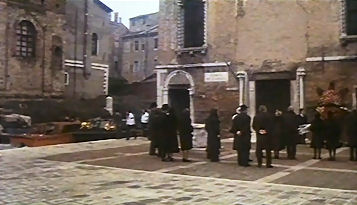
from Nero Veneziano
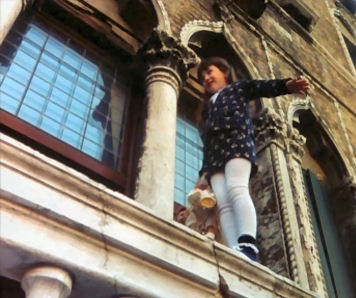
Two from Night Train to Venice
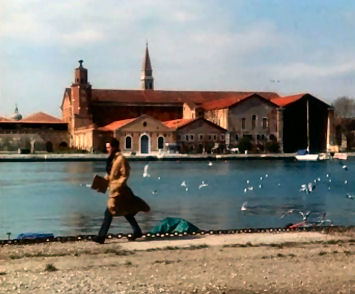
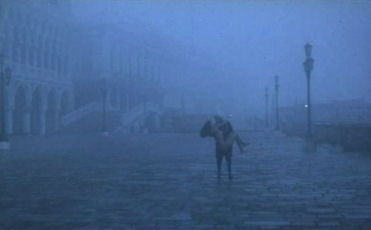
Two from Nosferatu in Venice
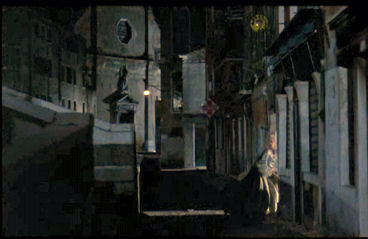
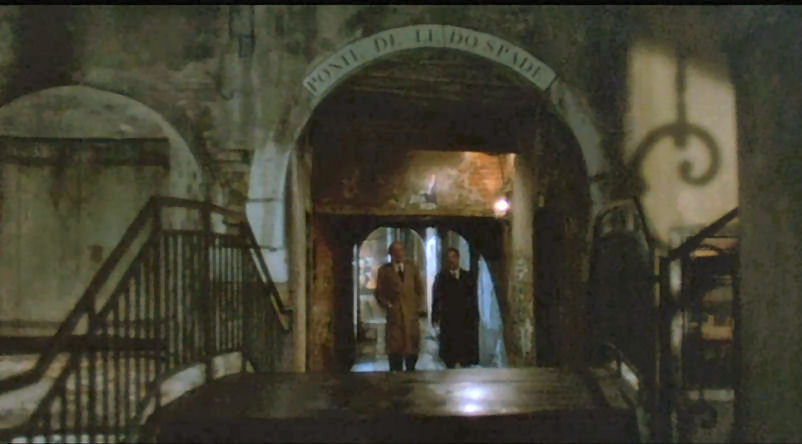
Two from Nudo di Donna
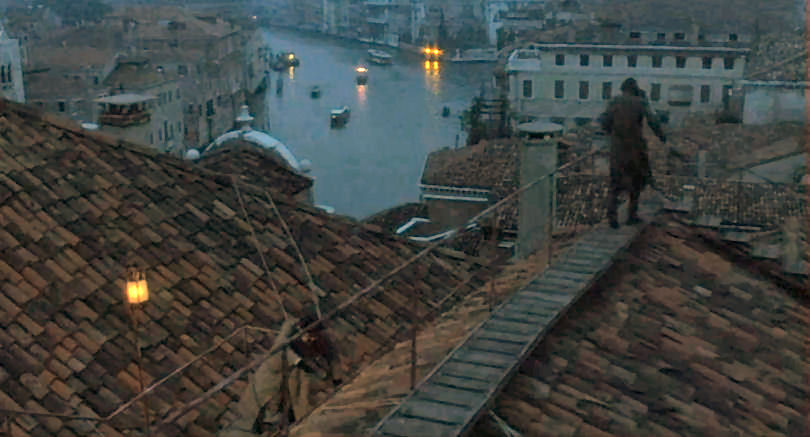
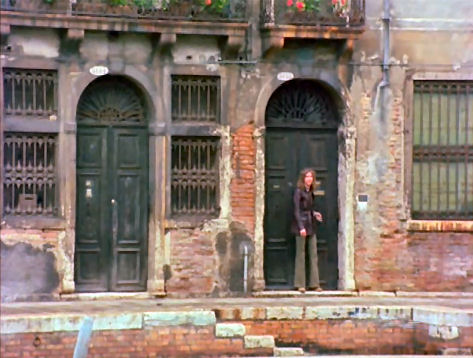
Two from The Protectors
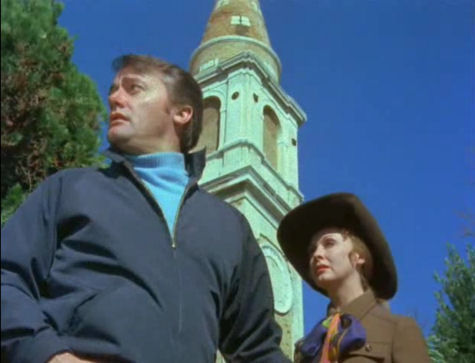
|
n[eon] 2002
Thirty minutes of monochrome arty treated-film slowness with voiceover
narration (by John Cale) and graphic jiggery-pokery, as you'd expect from
Dave McKean of arty-comics fame. There's a naked female ghost and
string-quartet music too.
Nero Veneziano
(aka: Damned in Venice)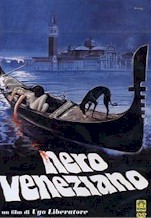 1978
1978
A fourteen-year-old blind boy and his sister have to move in
with their uncle and aunt when their granny dies. They go to live with them in
their dilapidated hotel on Giudecca. The boy starts to 'see' things, the relatives continue dying and so the scenes filmed on San Michele start to rack
up. The sister gets pregnant even though the mysterious stranger only felt her
up. The priest (who seems to keep heads in jars in his baptistery) starts
behaving oddly, especially when asked to baptise the child. Is the brother
deluded. Is the child the antichrist? Do we care? This is far from the worst
film set in Venice I've seen, but it's no masterpiece. Watched only a day or so
after Giallo a Venezia it sparkles a bit in comparison, and has a certain
creepy something. The photography and the script ain't bad at all, and the music
does the spooky discordant thing pretty well. It also gives good Venice -
one of the many funerals starts off outside Santa Maria Valverde, a favourite
spot of mine by the Scuola della Misericordia, as pictured (see left)
and behind the snogging couple in the still from Moonraker (see above left). There's a
runaway-pram scene filmed in the San Trovaso gondola repair yard and we get a
birth, a fire, a baptism and a decapitation, all on vaporettos. The typeface
on the vap stops looked much more stylish back in the 70s, even if the clothes
didn't. There's a fair amount of sex and stabbings too.
Nest of Vipers
1977
The original Italian title is Ritratto di Borghesia in Nero
which translates as Portrait of the Bourgeoisie in Black. A wide-eyed music student in Venice in the 1930s
gets to meet the family of a sleek-blond and knowing new friend, and so gets
to exchange meaningful looks and dialogue with the likes of Senta Berger, Ornella Muti
and Capucine. What initially might look like a revisiting of
Brideshead looks to actually turn into a more usual Italian affair of
inter-generational seduction and deception.
Night Train to Venice
(aka Train to Hell) 1993
Hugh Grant is a journalist catching the Orient Express
to Venice. He seems to have written a book about Neo-Nazis and has an
appointment to meet someone from the Inferno publishing house. On the train he
does his usual shy and floppy-haired Englishman routine (although with an
occasional Scottish accent) and so begins his frequent shagging of an actress
travelling on the train with her daughter. Malcolm McDowell is also on the
train and everything goes all weird and slow and odd music plays whenever he
appears and he says things like 'I know all of your fears'. So you're supposed
to think he's the devil, right, especially as he has a walking stick which he
holds up a lot and which has the head of the devil on it. Upon arrival in Venice our
Hugh shacks up with the actress in her palazzo, visits the publishing house,
which is based in a run-down and tatty corner of the Arsenale, it's deserted,
Neo-Nazi skinheads chase him in a truck (he's on a motorbike) they crash, he
gets amnesia, the actress nurses him back to health, he doesn't remember who she
is, but shags her anyway. She finds his floppy disc, he goes all funny, runs to
the palazzo, falls through a pane of glass and catches her falling daughter who
was walking along a balustrade. The music swells, a camera swoops around Venice,
more shagging, The End. There - you don't have to see it now, and you don't want
to. I have never seen such a poorly written, badly edited, downright insulting
piece of filmic poo in all my born days. Some nice shots of Venice though. And
the little girl who got caught by our Hugh grew up to become the winner of
Big Brother in 2008. I'm losing my will to live.
Another odd claim to fame for this film, learned
later, is that it features a final, cameo, performance by Kristina Söderbaum,
who appeared in the antisemitic propaganda film Jew Süss. She
appeared in many such films, produced by the German state-controlled
production company, due to her wholesome Aryan looks. Most of them ended
with her death by drowning, earning her the title Reichswasserleiche
(Drowned Corpse of the Reich).
No Sun in Venice (Sait-on jamais...)
1957
A film directed by Roger Vadim and released a couple of months after I was
born. It concerns a young French girl and her three lovers, one a forger and
a former-Nazi in whose palazzo she lives. The other two are a shady ex and a
handsome-but-honest photographer. Sounds like somewhat predictable tosh, and
the jazzy MJQ soundtrack seems to have aged better than the film, if you
like that sort of thing, but it was filmed in Venice in winter in the
mid-1950s, so might be worth a look.
Nosferatu in Venice
1986
Christopher Plummer is the vampire expert summoned to
Venice by a princess to investigate the tragic aura and history of her palazzo.
Later there's a séance, and she summons Nosferatu, played by Klaus Kinski. He
arrives, there's a carnival, he attacks women whose woefully badly-buttoned tops
fall off, choral music plays, blood flows...you get the picture? Yes, this is a
pretty old-style vampire film, where the vampire is neither young nor
cute, but with the added thrill of some well-filmed Venice. The look is
authentic and crumbly and foggy and mostly with that blue-filtered night-time
look. The interiors don't look like sets and the exteriors aren't just the
tourist spots. There are some inauthentic notes, though. Three exorcising
priests get thrown from a window at one stage and are impaled on the spiky
railings around a well head in a palazzo courtyard. Not sure why a well would
need railings. Also the plot resolves itself around the 'fact' that a vampire
will die if he is loved by a virgin. Actually this is interpreted as him dying
if he has sex with a hot naked virgin on a four-poster bed amongst peeling
frescos and sexy ripped curtains, but either way: a new vampire fact on me.
Another entertaining element is the music that plays whenever our heroine is in
danger, which sounds like a very cheesy ringtone. But I admit I found this an
entertaining and amusing Venice fix. Not a great film, or even a good one, but
enjoyable and not as bad as it could have been, given its rocky production
history which involved the hiring and sacking of four directors.
I acquired my DVD of this back in 2010 from
cinema-de-bizarre.com
who now seem to be defunct, but it's since been released on blu-ray in the
US.
Nudo di Donna
(aka Portrait of a Nude Woman)
1981
Well, here's a strange one, but a strangely witty one too.
It's the story of a couple - Laura and Sandro - who have come to
Venice from Rome to run an antiquarian bookshop. Their marriage
is hitting rocks so Sandro moves out and fetches up in his gay
photographer friend's leaky but baroque 17th-century palazzo. On a trip to
the toilet, which turns out to be a balcony overlooking a canal, he spots a
large photograph of a naked woman whose bottom seems familiar. And so begins
his puzzled quest to find out if Laura and Riri, the supposed possessor of
said bottom, are one and the same person. The dialogue is sharp, and there
is lots of location filming along canals and in campi which reek of Venice
but not of repetition or over-familiarity. Some stylish interiors too. The
backdrop is Carnevale, which is an excuse for masked and dressed-up people
to appear in the background and add to the film's surreal and tastefully
Felliniesque atmosphere. The ending is enigmatic, maybe, and the music's a bit
dated and 80s and cheesy, but this is an unusually intelligent Italian
comedy and a very Venetian visual treat. And any film which has a cat and a
tray of biscuits as crucial plot devices...
You can get a DVD of this from
moviedetective.net.
Othello 1955
Orson Welles's take on Shakespeare's play, filmed in black and white, with
much location filming in Venice, including the Moor's marriage to Desdemona in
the Miracoli church (see below).
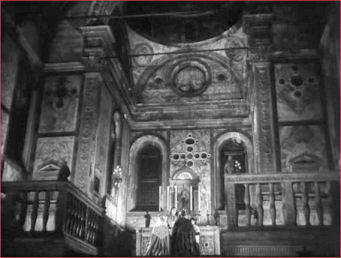
Passion in Venice 1995
Italian porn, which tells
one woman's story as she visits
Venice and 'tries to become acclimated to the spontaneous couplings that happen
all around her!' And haven't we all been
there?
Peccati a Venezia 1980
A love triangle plot involving cousins, a murder, and an elderly aunt. Online
reviews are all in Italian and pretty negative. Seems to give good Venice and to
be lightly pornographic.
Play me something 1989
In which John Berger collaborated with director Timothy Neat to film one of his
short stories, about a group of people waiting for a flight to Glasgow on the
Hebridean island of Barra. While they wait Berger himself, playing a
mesmerising storyteller, tells them a tale of a peasant on a trip to Venice. The
film mixes colour and black-and-white, 35mm and blown-up 16mm footage, and still
photographs by Jean Mohr. Sounds arty but interesting. A DVD or a download has so
far not been found.
The Protectors
This was a typically 70s Brit TV series featuring a
team of wealthy private detectives who jetted off to glamourous European
destinations to right wrongs. There were three in the team: Nyree Dawn
Porter played the wacky-hatted Contessa Caroline di Contini, Robert Vaughn was
Harry Rule, and there was a third bloke who everyone has forgotten. The series
was created by Gerry Anderson and was his one venture into non-sci-fi live
action. There were two episodes featuring Venice.
Season 2 Episode 7: Goodbye George
The Contessa has this episode to herself. She goes solo to
Venice to find out why a wealthy American's son who has moved to Venice to
develop his art and who previously had made little use of his inheritance is now
milking said funds mightily. Blackmail is suspected and the disappearance of his
good friend George is suspicious too. Watching this whisks you back to simpler
times, when tapping into the post-60s aspirational mood with some added mildly
sophisticated plotting was enough. It's not unentertaining, though, and features
some solid and realistic use of locations - San Marco, of course, but also the
San Trovaso boatyard and Campo San Barnaba (see left). And I have to admit there
was a nifty plot twist I didn't see coming. This episode was directed by Michael
Lindsay-Hogg whose other work included directing many Beatles and Rolling Stones
videos and most of the TV Brideshead Revisited.
Season 2 Episode 15: Lena
Plot sophistication is sadly missing from this one,
though, but Robert Vaughn and Nyree Dawn Porter do both appear. A journalist
called Lena, played by Judy Parfitt, is investigating the suspiciously sudden
rise of a rich right-wing politician. She's helped by a student activist played
by Roger Lloyd-Pack, and the slimy politician is a young John Thaw. The plotting
and action is pretty ropey, and Robert Vaughan strolls through the thing like
he's on his holidays. But we do get good Venice, from the statutory drinks on a
terrace with the Salute as a backdrop to the fish market and also some unusual
island action, including a sequence in some overgrown and deserted hospital buildings on the
island of Poveglia. See the screen grab with campanile (left). Also some
business, and a desperate van chase, on the Pellestrina riva.
|
|
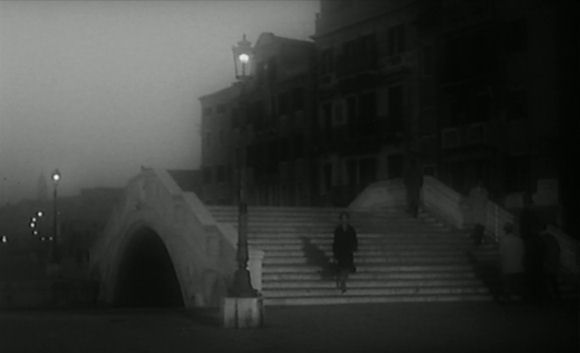
from The Redhead
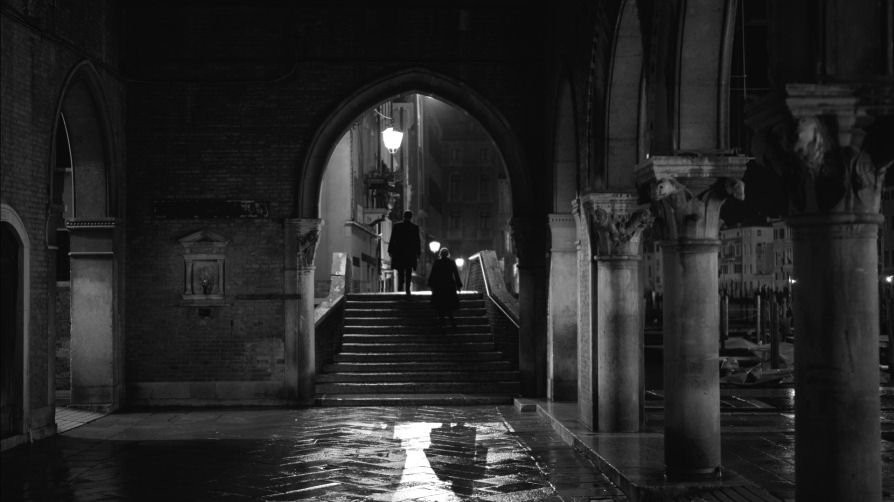
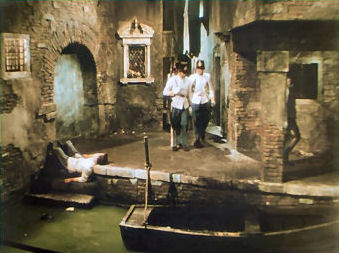
Three from Senso
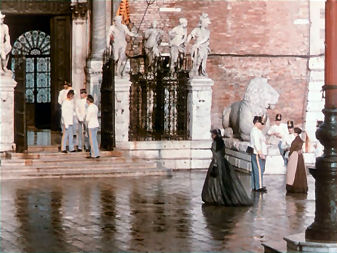
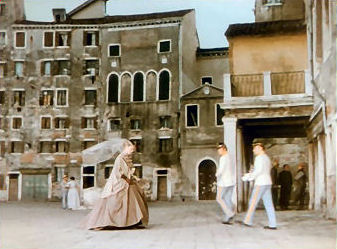
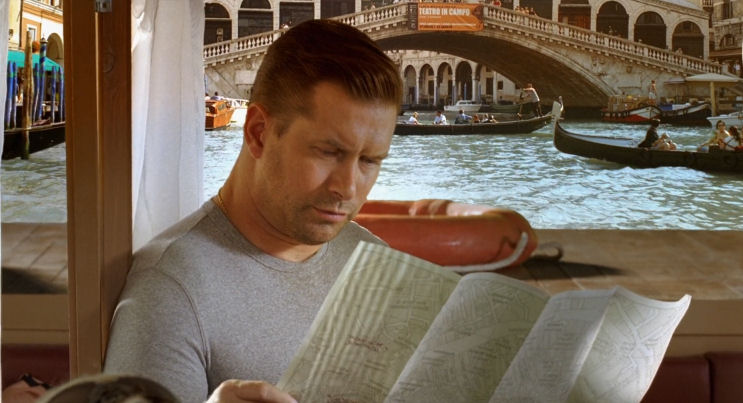
From Shark in Venice.
I'm sorry I couldn't find any scenes of fins breaking the surface of canals.
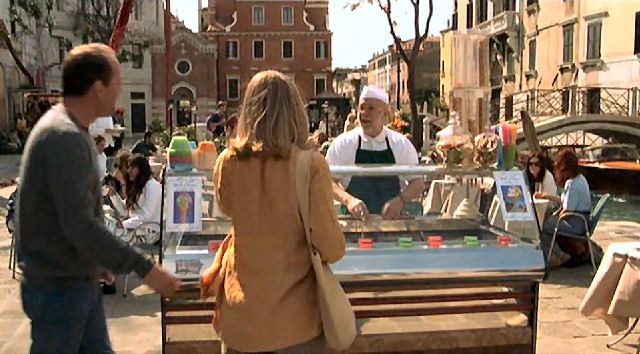
From The Story of Us
|
The Redemption of the Fish (La Redempcio
Dels Peixos) 2013
A Catalan film directed by Jordi Torrent. The blurb says: Marc travels to
Venice in a quest to meet the father he never knew - a rite of passage for a
young man seeking to make sense of his own life story - but in the process
he discovers his father’s murky past. As he enters the age-old labyrinth of
Venice with its temptations and its delusions, its beauties and its deceits
- what will he bring away? A wind-up musical gondola toy and a nasty
rash, I would guess.
The Redhead (Die
Rote) 1962
In this German film, made in black and white, Ruth Leuwerik plays a woman
who flees to Venice, from her life as a rich man's mistress, conveniently
married off to one of her lover's drier employees. You can see how she might
be having a bit of a life crisis. In a dark, damp and misty out-of-season
Venice she looks for work, ponders her life and choices, and meets two men.
Rossano Brazzi plays a witty writer of history books - a more obtuse and
scholarly version of the seducer he had played in Summertime. Giorgio
Albertazzi plays an Irish ex-spy, living off his family brewery fortune on
his yacht and haunted by his wartime failures, and by Gert Fröbe as his Nazi
nemesis. It's all very dark and philosophical, but with a wit that
effectively fends off frowns and pretentiousness. And this is the best out
of season Venice seen on film this side of Don't Look Now - all mist
and glowing lamps and lovingly filmed. Being made in black and white
somewhat dilutes the narrative import of her redheadedness though.
Le Retour de Casanova 1992
Casanova
now has his own
page
Ripley 2024
This new Netflix adaptation of
Patricia
Highsmith's The Talented Mr. Ripley takes the form of
eight episodes of black-and-white gorgeousness, with the last one set solely
in Venice, and the penultimate one featuring a very sinister but fluffy cat.
Previous episodes had seen Tom Ripley, played by Andrew Scott, move through
sculpture-infested and crumbling ex-palazzi in Naples, Rome Palermo and
Atrani taking on the identity of the man he'd been employed to persuade to
return home. There's believably unplanned brutality and complications
aplenty. And then there's the photography. I hesitate to use a cliché like
'every frame is like a well-composed photograph' but it's true. See left
and below.
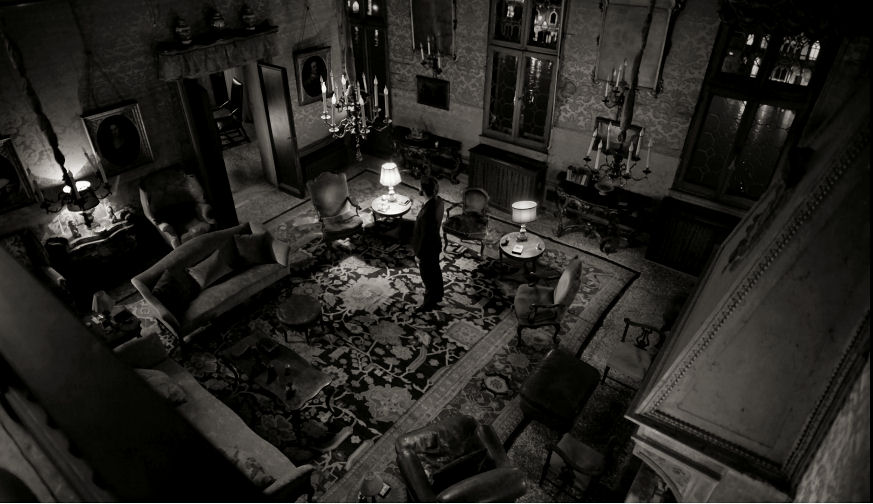
Rouge Venise 1989
A French film set in 18th-century Venice, a murder
mystery featuring Goldoni and Vivaldi.
The Scapegoat 2015
Three jewel thieves are hiding out in Venice after
a job goes wrong, deciding who's going to take the rap. So not a million
mils from the plot of In Bruges. Written and directed by Cathy
Beasley who was also responsible for A Venetian Dream, released the
same year.
A Secret Affair
1999
A telly film based on a Barbara Taylor Bradford novel. A
beautiful business women on holiday in Venice has a thing with a pushy Irish
TV reporter and starts to question her hollow money-based lifestyle. I
sampled this on my computer to see what it was like. It seems to give good
Venice in the first hour but, although she seems good enough, he was very
annoying and stiff, even when I was just skimming. I may do it justice, I
suppose, one rainy Sunday afternoon.
Secret Passage 2004
Set in 15th-century Venice, the story centres on Jewish
sisters fleeing persecution in Spain, and seems to involve the stealing of
Murano glass-making secrets. Stars include John Turturro and his wife
Katherine Borowitz, another Coen brothers regular, and amongst the Brits are
Tara Fitzgerald and noted thesps Anton Rodgers and Ronald Pickup.
Senso (aka
Livia)
1954
This is an earlier Venice-set film from Luchino Visconti, the
director of Death in Venice, but it's not a patch on
The Leopard. It's set in the final days of the Austrian occupation
and tells the pretty predictable tale of a contessa's doomed infatuation
with an Austrian soldier. Farley Grainger makes a good handsome heartless
bastard, but is ill-served by bad dubbing. Alida Valli shines as the
Contessa. There's a mess of heaving bosoms and breathlessness behind veils,
with plenty of trousers with stripes up the legs. You get the picture? There's also some good Venice in the first half hour, and the photography is
generally pretty special. The film opens with a performance at La Fenice and following the most recent fire enlarged stills from this sequence
were used in the restoration. Much footage was cut from the final battle
scenes, it is said, by the Italian government to blunt its criticism of the
feebleness of the ruling class's commitment to the Italian cause at the
time.
Senso '45 (aka Black Angel) 2002
This comes courtesy of Tinto Brass, the director of
Caligula, so you'd expect soft-core porn with a thin veneer of European
'respectability'. What you'd not expect is for the Italian arts ministry to
consider it 'culturally significant' enough to put 1.6 million Euros into
it. The film is truly tosh, and not even that sexy. Based on the same novel
by Camillo Boito as Senso above, but this time the setting is time-shifted
to the last days of the Nazi occupation.
Shark in Venice
2008
Starring Stephen Baldwin, this is reportedly not so much a Jaws rip-off as a
gangster-filled Indiana Jones rip-off. Stephen is not the talented Baldwin
and the director, Danny Lerner, is reputedly a safe pair of hands when it
comes to B-movies, but is here working much further down the alphabet. The
plot involves Baldwin's character searching for his father, who disappeared
whilst diving in Venice. His investigations uncover Mafia connections and a
search for the lost fortune of the Medici. The sharks seem to be an
afterthought. There's filming in Venice, but Baldwin seems to have
been superimposed over it later. At one stage a baddie under the arches of
the Doge's Palace keeps an eye on Baldwin and his girlfriend whilst the pair
of them are in some kind of generic brick-walled street market, obviously a
set. There's also some underground action, despite Venice having no ground
to get under. You can watch this on Amazon Prime. By sampling scenes I can
confirm that this is indeed tosh, the kind of film where the black-clad
baddies can also be identified by how they recklessly barge through crowds,
knocking people out of the way. Bastards!
Shun Li and the Poet 2011
The story of the relationship between a young Chinese woman and an older
fisherman from Yugoslavia living in Chioggia.
The Siege of Venice (Caccia alla Vedova) 1991
A Russian film in which Isabella Rossellini plays a woman widowed
on her wedding day who thereby becomes very wealthy and so is plagued by
suitors, and the Republic of Venice who fear that her money will go abroad
if she marries a foreigner. It's based on a Goldoni play called The Sly
Widow and it's pretty broad unsubtle stuff. I laughed maybe three
times. It features Tom Conti with an accent and performance seemingly based
on Manuel in
Fawlty Towers, and James Wilby as a cold Englishman. What it doesn't
feature is Venice, as this was all filmed on sets in Moscow. But it's short
and it looks good.
Solamente Nero 1978 Antonio Bido
A giallo which went under the English title The Bloodstained Shadow,
which somebody must have thought was clever. Reportedly as gruesome as you'd
expect but not as good as you'd want. Mostly filmed in a misty wintry
Venice.
The Specialist 2007
This page isn't short of soft-core porn filmed in
Venice, but hard-core stuff is much less common. The opening credits feature
a surprisingly well-filmed vaporetto ride down the Grand Canal, centred on a
central character, and a stroll through the Piazza. Then the plot, such as
it is, is introduced in supposedly Venetian interiors with some easily
excitable women wearing just their scanties, for some unexplained reason.
But the Venetian action (and 'action') soon ends, as we move to more
tropical climes where nothing much happens that doesn't rhyme with duck.
The Story of Us
1999 Rob Reiner
Bruce Willis and Michelle Pfeiffer play a couple whose
relationship has hit big rocks. Their attempt to salvage something involves
a short trip to Venice - no more than ten minutes. It
involves a gelato fridge miraculously appearing in Campo San Vio (see
right) and the obligatory meal on the hotel terrace opposite the Salute.
On the whole this is not a film I can recommend, or want to see again. It
lacks conviction and spark and originality. I can best describe it as one of
those films where the troubled couple goes from calm discussion to shouting in no
seconds flat, in a frown-inducingly unconvincing way. Bruce Willis looks
uncomfortable without a gun in his hand and Michelle Pfeiffer just looks a bit
weird. Did she have work done (on her lips?) in the 90s? |
|
Summertime
1955
|
|
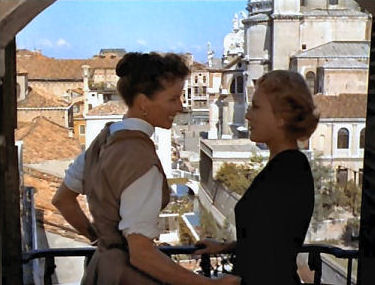 |
David Lean made this film, known in the UK as
Summer Madness, two years before he made Bridge on the River Kwai.
It stars Katharine Hepburn as an inexperienced American woman getting a
good romancing from Rossano Brazzi in Venice. It's a thin story - adapted by
Lean and H. E. Bates from a play by Arthur Laurents called The Time of
the Cuckoo - of a lonely woman
looking for love and not knowing how to deal with it when it takes pushy and
suave grey-templed form. Venice glows, though, and is the main reason for
watching. The hotel where Kate H. stays is called the Pensione Fiorini in
the film. This is not just a fictional hotel, it is a miraculous hotel. Its entrance is near San Marco, our heroine's room overlooks the
Salute church and the terrace of the hotel seems to have been specially
built on Campo San Vio. This is all filmed on location, but there are some
outrageous liberties taken with geography all through the film, with the
turn of a corner often taking the action instantly to somewhere far away. A shoe shop appears next to the Salute where no shops are, a dress shop is
created in front of the church of San Gregorio and Katharine H. falls
into a suspiciously clean canal in Campo San Barnaba. This is a film made in
more innocent times, though, where sex is suggested by fireworks going off,
Venice's churches are all covered in grime, and small children smoke
cigarettes, so allowances must be made.
For a whole page devoted to Summertime
location-finding click
here
There's some fascinating background info
here
too.
|
|
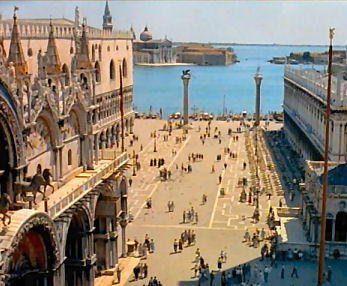
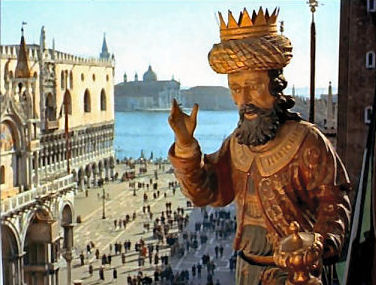
|
|
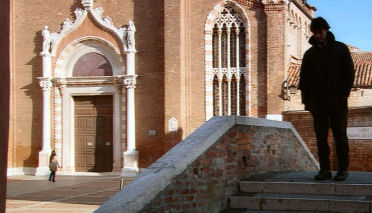
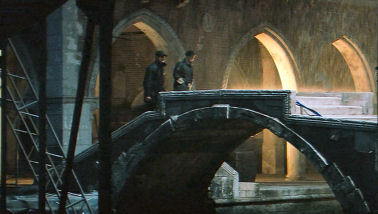
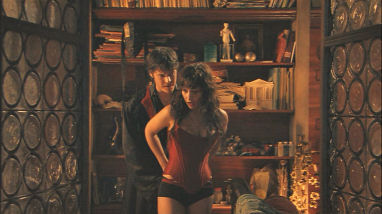
Three from Tempesta
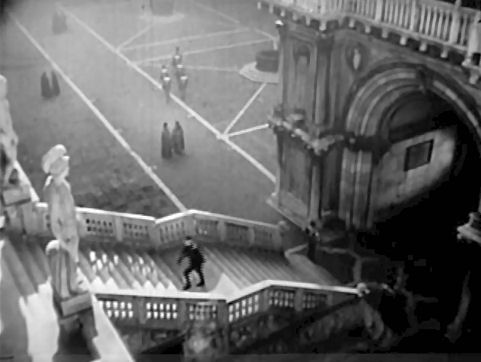
Two from The Thief of Venice
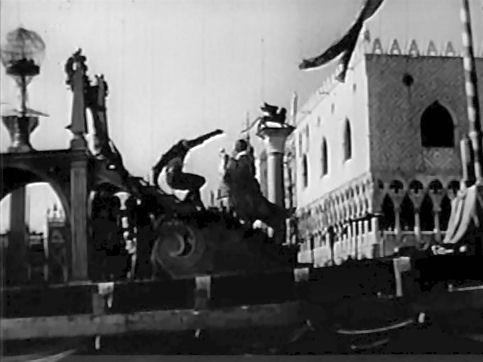
|
The Tales of Hoffmann
1951
A Powell and Pressburger film in the Red
Shoes vein, which I confess I've never seen.
Tempesta
2004
This is based on a novel I quite liked, but
it didn't get released in the UK, and is currently only available on DVD in
Germany, where it's called Der Venedig Code, presumably in an attempt
to attract the Da Vinci Code audience. Bearing all that in mind my
hopes weren't high, but the DVD was pretty inexpensive. On the plus side it
gives very good Venice, with lots of arty photography and 'creative'
dissolves and much fine footage shot in the winter in the rain. There
is also a recurring scaffolding motif throughout, for some reason. The plot
features some standard art world corruption and forgery shenanigans, with a
good body count and Malcolm McDowell doing his tanned and reptilian old creep
thing again. The film-makers try hard to make art-authentication sexy,
mostly with the use of some unconvincing hi-tech laptop wizardry and
intrusive techno music. The art-history stuff is mostly pretty convincing,
with the names dropped mostly fitting in and the technical stuff sounding
authentic. I'd class it as pretty solid entertainment, then, if you don't
expect too much.
The Thief Lord
2005
Adapted from
a book I liked
this went straight to video in the US. strange that it wasn't better
promoted to ride the Harry Potter wave, because it ain't that bad. It tells
the story of two orphans who escape a gruesome Uncle and Aunt and flee to
Venice to join a gang of urchins lead by the Thief Lord, who wears a
pointy-nosed mask and steals to keep the gang in food and living in a
disused cinema. Add a cuddly private detective hired by the Uncle and Aunt
and a sexy older woman who's the detective's friend and you can probably see
where this is going. But it gets there with neat twists and magical
business, of course, and some solid Brit acting. It's all very British, with
irate boat-owners shouting Oi, you there! and only the occasional bit
of chucked-in Italian to add flavour. There are some cringe-worthy bits,
true, but some clever pieces of business too. And it all looks pretty
stylish. The location filming is an attractive mixture of the sparkling and
the real, the night-time romance and the graffiti. Bits are filmed in
Luxembourg, of course, as there's not a Venice film that hasn't been filmed
there too in many a moon. The DVD just contains some OK deleted scenes and
trailers, along with some annoying and unskippable anti-piracy propaganda.
This has the magic, the atmosphere, the loveable tykes and the suggestions
of teen romance that go to make a Harry Potter, plus Venice. What more do
you need to know?
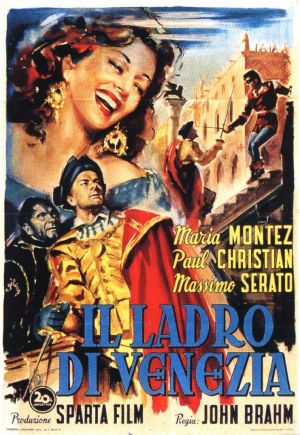
The Thief of Venice
(Il Ladro di Venezia) 1950
Grand Inquisitor Scarpa (Massimo Serato, later to appear as the Bishop in
Don't Look Now) has his sights set on becoming the next Doge. He poisons
the incumbent, steals mightily from the official coffers, and sends a
pitiful small fleet commanded by his enemies to face a massive Turkish one.
But a single galley makes it back, and Lorenzo Contarini (Paul Hubschmid),
when Scarpa's treachery becomes obvious, sets about toppling the villain,
with the help of the common people, led by tavern-keeper Tina. This is an Italian-American co-production starring Maria Montez (in her final film)
as the tavern keeper. The story and dialogue strike almost no false notes,
and get an awful lot right. It's all filmed in Venice too, from the slimy
streets to the big finale - a huge ceremonial wedding complete with
processions across the Piazza and huge barges, and everything. It was
directed by John Brahm, who also directed
Hangover Square and The Lodger in the 40s, and episodes of The
Man from UNCLE in the 60s. It was made in black and white, and the copy
I watched, which will in all probability be the same one you get to see, if
you can, is pretty rough. It has a very jumpy start and is dark throughout,
but it's very watchable and the darkness adds mystery, especially to the
night-time sword fights, where you have absolutely no idea what's going on.
An enjoyable romp, then, and well worth tracking down and watching, for
getting so much right.
The Tourist
This film got such bad reviews when it came out that I shouldn't have been
surprised at how truly awful it is. But I was. It's the worst film I've seen
in ages, and I speak as the man who recently watched Nero Veneziano
and Giallo a Venezia for reviewing on this very page. I watch them so
you don't have to! Angelina Jolie is the girlfriend of a very wanted man who
is instructed by him to board a train to Venice and to chummy up
to a random chap so the police will think that this chap is actually said wanted man
after much expensive plastic surgery. The random chap is played by Johnny Depp and he and Angelina have as much chemistry as a maths lesson - they
act like they're acting the whole time. The plot plods by on the way to a
surprise I'll not reveal because it would insult your intelligence to
suggest you hadn't guessed it already. Also annoying is the way that every
man that Angelina sashays past HAS to then watch her departing
bottom with that 'phwoar!' look on his face. The Venetian locations look nice
and sparkly, but the liberties taken with geography are extreme. The worst
two are having the Doge's Palace opposite Santa Lucia railway station and
the airport situated on the Zattere opposite the Redentore church. But
really even for us location-porn addicts the odd recognition of a favourite
palazzo or campo just isn't enough to make this a worthwhile watch. Avoid!
The extras on the DVD/Blu-Ray include Tourist
Destination-Travel the Canals of Venice, a 3 minute
documentary about Venice, and a director's commentary that is more engaging
than the film, but that's hardly hard to achieve.
Unforgivable (Impardonnables)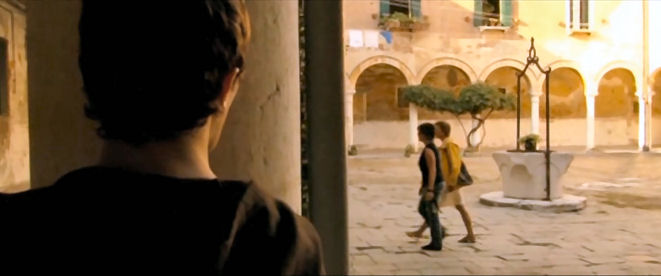
Directed by André Téchiné and shown in the Director's
Fortnight section at the 2011 Cannes film festival, but reputedly
a stinker. André Dussollier plays a writer who goes to Venice to work on a
new book and there embarks on an affair with an estate agent who'd
previously had a lesbian affair with an alcoholic private eye, so he employs
her to search for his daughter who's disappeared with an aristocratic drug
dealer, and then gets the PI's son to spy on his wife. Can it be as bad as
it sounds?
|
Us
2020
A BBC adaptation of the novel by David Nicholls, broadcast in four one-hour
episodes. It tells of a couple taking a grand cultural tour of Europe with
their son, who is about to flee the nest for university. Just before they
depart, though, the wife tells her husband that she thinks that they should
separate. They eventually decide to go ahead with the trip, with much
ensuing exposure of fault lines. Tom Hollander plays the husband, Douglas,
cuddly but pompous, and Saskia Reeves is Connie, the wife who understands
and smoothes. The second half of the second episode and the first half of
the third are set in Venice, but not one you'll always recognise. Alongside
the plot-central Salute church and San Zanipolo, and many recognisable
canals and alleys, there's a heavily-featured campo with a fountain in it
that is nowhere I recognise (see right), and how many campi in
Venice have fountains? Some alleys are suspiciously hilly too (see right),
and there are a couple of unrecognisable churches. This all comes together
in a long scene where Douglas walks through Venice at night with the woman
he meets in his hotel (played by Sofie Gråbøl of The Killing fame)
along totally unrecognisable, and slopey, streets past a church in no Venice
I know. When the action moves to Siena none of the locations there are at
all familiar, or feature Sienese landmarks. In the book he dozes of in the
Piazza del Campo, here he dozes of in front of an Italian church I don't
recognise. Flashbacks to the couple's courtship and marriage intersperse the
trip, with a party departed in a street in Tooting, just minutes away
from where I live! Watch this for the amount of good Venice that it it
gives, even when it's not actually Venice you're looking at, and for the
realistic situations, believable emotions and superior acting.
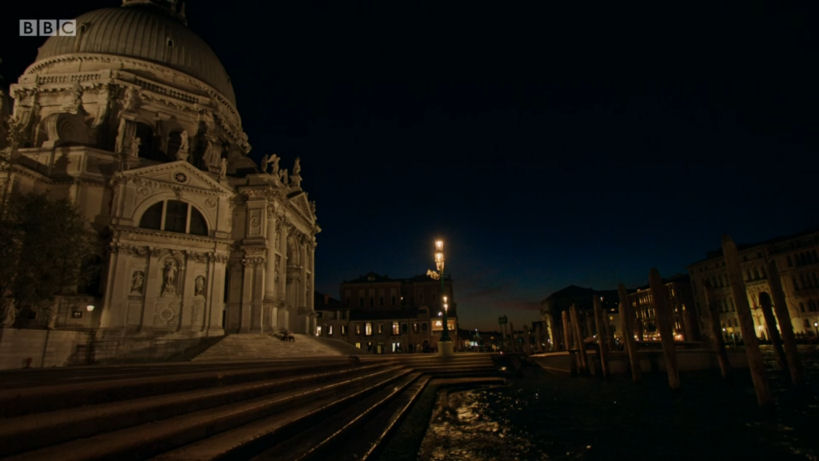 |
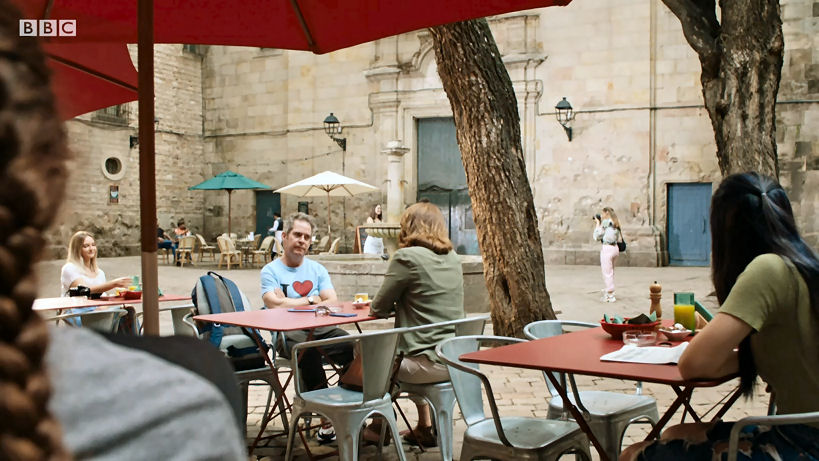
The mystery campo in Venice in Us,
and a strange hilly Venetian alley.
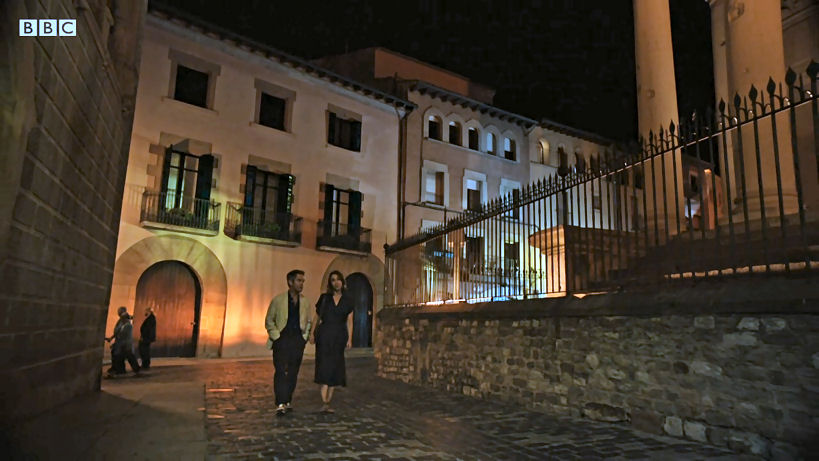
|
Veneciafrenia 2022
A Spanish slasher about a party of hard- partying young Spanish tourists
whose time in Venice is somewhat spoiled by their getting bumped off in
various gory ways by locals, dressed for carnevale, resentful of
disrespectful tourists. One way of solving the problem I suppose. They
swear a lot and don't seem keen to visit any churches at all, so death's
too good for them, I think. Looks nasty.
The Venetian Affair
1967
I had read somewhere that this film, based on a Helen MacInnes novel,
was one of those arch
late-60s spy spoofs, but it plays pretty straight, at least until about an
hour in, and even then I'm not sure that the hokeyness is intentional. Robert Vaughn
stars as an ex-CIA agent with a past and a drink habit, sent to Venice to
investigate an exploding diplomat at a peace conference. The ensuing plot involves
mind control drugs (always a convenient solution for lingering plot holes), plush sets, double agents aplenty and a Lalo Schifrin
score, of course, featuring bossa nova dulcimers. It also has Carl Boehm
playing his usual cold Eastern European slime ball, Elke Sommer playing
Vaughn's past, Boris Karloff in one of his last films, and
Edward Asner. The Venice we get is unglamourous and often wet and nicely filmed.
There are a couple of puzzling interiors - one is supposed to be the inside
of San Zanipolo, but isn't. This film was banned in Finland, was never
released in the UK, and
evidently the tagline on the publicity for it was Vaughn! Venice! Vooom!
Entertaining enough, but I wouldn't say special.
The Venetian Affair
2008
A film of the Andrea di
Robilant book has been 'in development' for years.
Venetian Bird
(aka The Assassin) 1952
Not a film I'd heard of or a book
I'd read when, in 2013, I got told about the film, read the book (which had
only just been republished as an ebook) and then the film came out on DVD.
The film follows the book's plot very closely, not surprising as author
Victor Canning wrote
the script too. I won't repeat the plot as I cover it in
the book review. It
is not without its conveniences but also has some snappy dialogue and zips
along in a roughly believable fashion. John Gregson is Edward Mercer, our hard-bitten hero,
with Eva Bartok the icy love interest and old standbys like Sid James,
George Coulouris
and Miles Malleson giving their Italian accents a work out. (Eva Bartok had
married a Nazi at 15 to save her life, had starred with Burt Lancaster in
The Crimson Pirate around this time, went on to marry Curt Jurgens, was
cited in a Mountbatten's divorce case and had a love child she claimed was Frank
Sinatra's). Director Ralph Thomas is more famous for directing the Doctor
films. Lots of Piazza San Marco scenes, as usual, but the rest of the filming is mostly around Dorsoduro -
the Salute, of course, but Campo San Vio (used for the hotel terrace in
Summertime a few years later) features as the campo in front of the villain's
plush art gallery,
and the entrance to the cloister beside Santa Maria della Visitazione
stands in for a Murano glassworks. The Maddalena church gets named and
darkly and mistily used early on too. This is lived-in Venice rather than
touristy Venice, which is refreshing, but there's another rooftop chase
finale and the usual liberties with topography are taken.
Venetian Dream 2015
Written and directed by Cathy Beasley who was
also responsible for The Scapegoat, released the same year. But I
can't find a plot for this one.
Venetian Honeymoon 1959
Directed by Alberto Cavalcanti, who was also responsible for several 1940s
Ealing gems, like Went the day well? and Nicholas Nickleby.
An Arab prince turns out to be an impostor, there are jewels to be stolen...
Loosely based on the novel Les noces vénitiennes
by Abel Hermant, this Italian/French production looks only to have ever been
released in France and Italy.
La Venexiana (The Venetian
Woman) Italy 1986
This film has the reputation of being soft-core porn, but it
really isn't. The acting is solid, the dialogue quite witty, the camera
work, design and costumes impressive, and the Ennio Morricone music is amongst
his best, even sounding like Chi Mai in places, and without the
screechy children's choir he sometimes favours. In fact there's something
almost Shakesperean (no, really) about the much to do there is here, about
nothing more than two older women wanting to shag a handsome foreigner, new
in town. There's even some jaunty and unconvincing cross-dressing. The
stranger is played by Jason Connery, just months before his career-defining
turn as Robin Hood on TV. You don't get to see his willy, of course, and
actually there's more location porn action here than the other sort. Lots of
filming around San Zanipolo, the Miracoli church, and Palazzo van Axel, with
some scenes around the Misericordia too. All places not unknown in
Venice-set films, but all looking very grimy and unkempt. Not bad at all.
Available on DVD in Italy.
La Venexiana
Italy 1998
The second film with this title features the adventures of the daughter of a Venetian patrician
family in, it looks like, the 18th century. Casanova's ghost also puts in an
appearance.
Venice, the Moon and You (Venezia, la Luna e Tu)
1958
Directed by Dino Risi and starring Alberto Sordi, the
latter being big in Italy but not so well-known elsewhere. He plays a
gondolier about to marry his childhood sweetheart, she having insisted he
give back all the gifts given to him by his gondoliering conquests, and that
he stop transporting attractive tourists. But then along come a comely
pair...
Venice: Theme and Variations 1957
A 28 minute documentary made by James Ivory (of
Merchant Ivory fame) as his master's thesis at the University of Southern
California film school, which makes it his first film.
Update 2023
Still not available on DVD or to stream.
The Venice Project
1999
Dennis Hopper plays an avant-garde artist living in
Venice, California whose sister, played by Lauren Bacall, is living in the
family palazzo in Venice, Italy. Their father The Viscount, played by John
Wood, is near to death and announces that he's going to bequeath the family
home and its art treasures to the nation. All this against the backdrop of
the Biennale. It also stars Linus Roache, Ben Cross, Dean Stockwell, Stockard
Channing, and Mia Maestro (Sydney's sister in the TV series Alias).
Why did we never get a chance to see this, it being so star-studded, and why has it never made it
onto
DVD or any streaming platform? The fact that some sources give Hector Babenco - who also acts in the
film - as the director, and the
imdb has Robert Dornhelm, may give some clue to some problems in the
making.
Venice/Venice 1992
Director Henry Jaglom is in Venice, Italy for the film
festival, where a gorgeous French journalist/fan takes his fancy and
something develops. Later she comes to Venice, California where he lives, to
stir up his life. This is one of those pseudo-real jobs, where people talk a
lot about reality and fiction and love and life and compare their lives to
films. It's a bit like Woody Allen with less laughs, but mostly it's solid
involving stuff. Most of the Venice, Italy content is around the Lido, but
there are a couple of quite nice trips down canals in Venice itself. One for
fans of Jaglom rather than fans of Venice, I think, but it has whetted my
appetite for more of his work.
Welcome Venice 2021
An Italian film in which two brothers in conflict
embody Venice's past and future, one being a fisherman and the other keen to
embrace the prosperity offered by tourism. As of July 2022 it's only been
released in Italy, Poland and the Ukraine. The names of all involved are new
to me, but the film looks to give authentic Venice. I can't find English
subtitles but sampling through it it looks to be full of
real-life, dialogue, natural-light photography and small crabs.
A Whisper in the Dark (Un Sussuro nel buio) 1976
Straight off I need to say that this film has about 5
minutes of Venice in it. The blurb says that the action's set in a 'decadent
Venetian villa', but it's actually the Villa Condulmer in Mogliano on the
mainland. But to fend off my feelings of foolishness at having bought the
damn thing I'm reviewing it here, and telling you it's a treat for the eyes
and torture for the ears, much like Who saw he die? below. Bad
dubbing, cheesy music and dialogue, and a children's choir going 'la la la'
at regular intervals is set against some notably opulent design and good
camera work.
Who saw her die?
Directed by Aldo Lado, this is an Italian film starring
worst-Bond-ever and chocolate advert star George Lazenby, sporting some
tragic 70s facial hair, as an artist hunting the killer of his daughter in a
tastefully misty winter Venice. It's kind of like Don't Look Now -
kind of - except that this one has some soft-core porn, is a bit more nasty,
and has a soundtrack featuring a screechy kids' choir written by Ennio
Morricone. The photography is actually pretty good, with some good use of
locations, including a memorable pursuit through the then-derelict Molino
Stucky on Giudecca - see below. (It's now a
luxury hotel, but the windows remain the same.) The film has a washed
out look, though, which may be intentional, or the fault of an old print;
and some of the the dubbed dialogue is truly atrocious. I doubt there's a
subtitled version available - I watched a cheapo video available from
www.salvation-films.com Easy on the eye, but hard on the ears, this
one's well worth a look, then, if you too see it in a bargain bin.
Update This is now available on DVD and
streamable on Amazon, and it turns out that the
washed-out look was down to the video, as the picture quality of the DVD is
first rate and sharp. This helps accentuate what's good about this film, but
the not-so-good acting and ropey dubbing remain. Still, this gives great
Venice, using backstreet locations and looking really real. The DVD extras
often
include a short interview with the director in which he reveals he grew up
in Venice and wanted to show a non-touristy and grimmer side of Venice.
Mission accomplished.
|
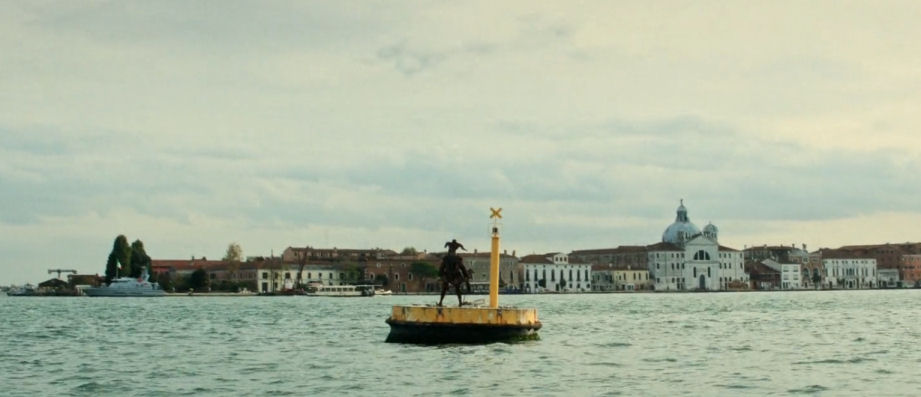
From
Veneciafrenia
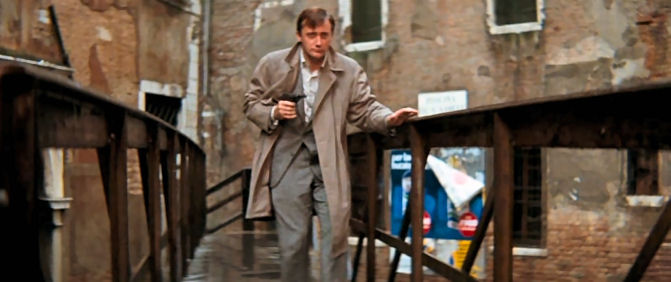
From The Venetian Affair 1967
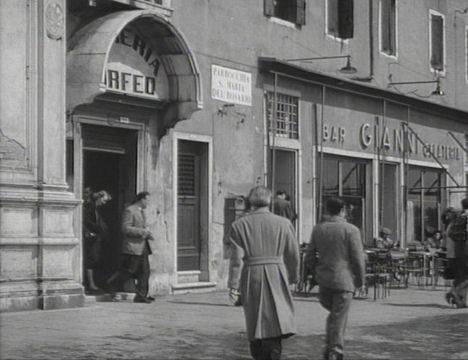
Two from Venetian Bird
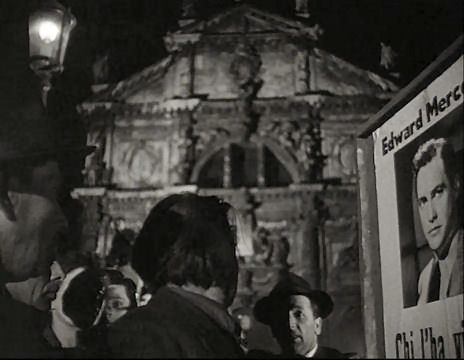
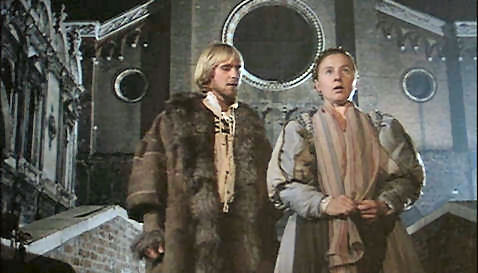
Two from La Venexiana
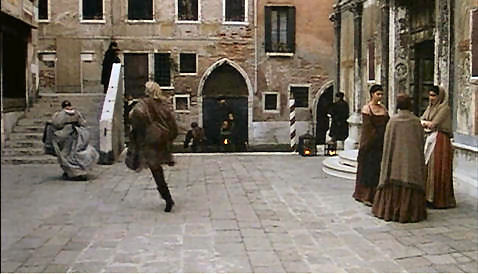
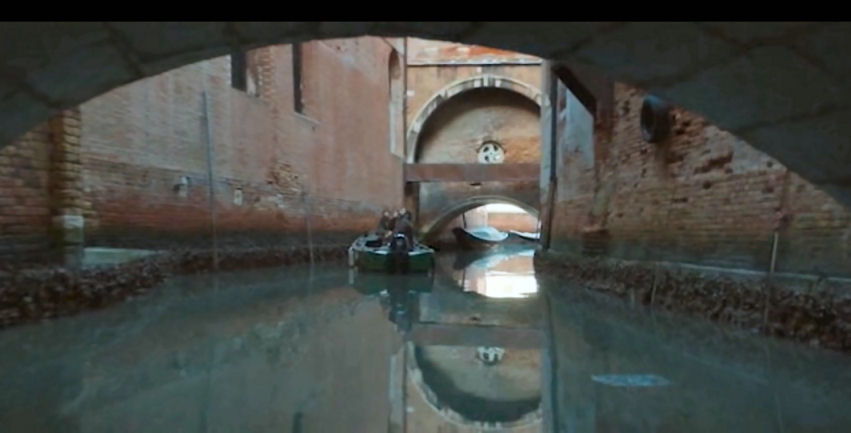
From Welcome Venice
|
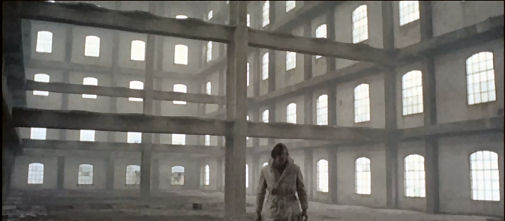 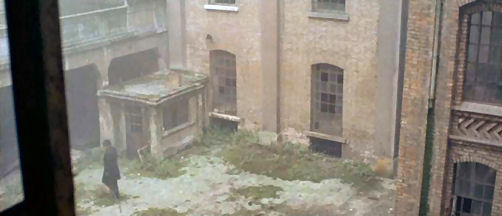
|
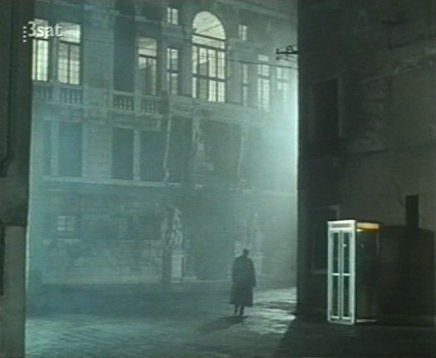 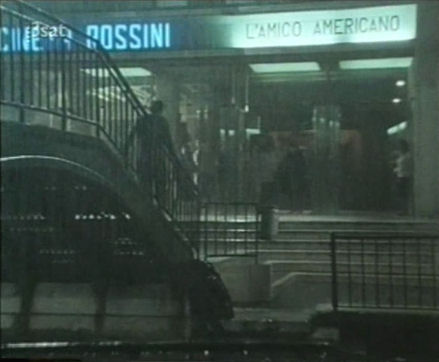 Who was Edgar Allan? (Wer war Edgar Allan?) Michael
Haneke 1985 Who was Edgar Allan? (Wer war Edgar Allan?) Michael
Haneke 1985
This is an Austrian TV film directed by Haneke early in his career,
taken from a novel by Austrian author Peter Rosei which doesn't seem to have
been translated into English. It concerns an art history student living in
Venice whose studies seem to consist of sketching putti. He lives on
takeaways, cigarettes, cocaine and double espressos. He meets a mysterious
American called Edgar Allen who seems unduly concerned by (and possibly
with) some recent local murders. Time passes, rain falls, bottles break,
mist drifts...the plotting and dialogue have the enigmatic qualities you'd
expect, plus some very impressive photography that might be less expected.
This one gives ravishing Venice, whether it's misty night-time chases or
stonework in daytime raked by strong light. This look is tempered more than somewhat
by the somewhat fuzzy copy I found,
which looks to have been VHS'd off the telly.
I think that the subtitles are the work of a fan and, whilst adequate,
they could be better. Let's hope that this one gets a proper release one
day, then, as I'd love to see it sharper, and to watch it again in the
hope of figuring out what it's all about.
Update 2025 Still
not available on DVD or to stream.
|
|
The Wings of the Dove
|
Based on a typical Henry James novel. Helena Bonham-Carter
plays Kate Croy who has been placed in the care of her rich aunt (Charlotte
Rampling) by her dissolute father. The aunt disapproves of Kate's
relationship with lefty journalist Merton (Linus Roach, introduced to us
ranting about the rich with his mates in a pub) and threatens withdrawal of
care and funds should the relationship continue. Into this drops Milly
Theale, a very rich American indeed, who becomes enamoured of Kate and
Merton and invites them to Venice, where things get complicated. Venice has
never looked more gorgeous on film - blimey even London looks fine and
Edwardian with lots of looming grey buildings and a period
tube station. The palazzo that Milly rents, called the Palazzo Leporelli in
the book, is here stood-in-for by
Palazzo Barbaro, where Henry James famously stayed many times. Our
heroines enter the palazzo, go up the stairs in the courtyard, and walk
through the central sala to the windows overlooking the Grand Canal in
exactly the same way as Charles and Sebastian do in Brideshead Revisited
above, but at night. The photography, the emotional stuff and the frocks
gave me goose pimples, damp eyes, and an unusual admiration, respectively. A
lovely and moving film and yes, of course there is a gondola funeral.
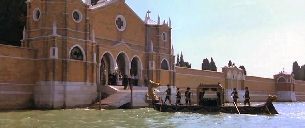 |
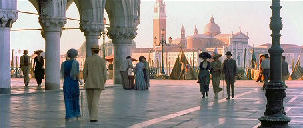
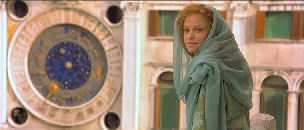
|








 Who was Edgar Allan? (Wer war Edgar Allan?) Michael
Haneke 1985
Who was Edgar Allan? (Wer war Edgar Allan?) Michael
Haneke 1985